Introduction
Background of the Research
In the recent decades globalization has significantly impacted sport in general and basketball in particular. Many basketball training and coaching techniques, as well as success formulas became globalized, however despite these trends there are still significant differences in the way basketball is approached in different countries. Based on the scope of relevant examples, this research will compare and analyze the basketball organization systems of Spain and China, and obtain systematic data conclusions. It is interesting to acknowledge that at U12, the male basketball players do not reflect considerable difference across different countries, however with the flow of time difference becomes stark and at U18 it is possible to see two totally different styles of basketball play. Each of them has own advantages and own disadvantages. The ability to understand own strong and own weak sides and the ability to learn from the success and failures of others would determine the basketball winners and losers of tomorrow.
Theoretical and Practical Importance of the Study
This thesis can be used both for theoretical and practical purposes. The students that study sport in general and basketball in particular can use it on theoretical level to better understand the contemporary coaching practices, training tools, performance measures, motivations and goals of basketball players and coaches, as well as numerous other related topics. The theme unites the West and the East, demonstrating different approaches to basketball in different parts of the world. Thus, this comparative analysis of the basketball organization system in China and in Spain can serve either as source of information or as a foundation for future research in this sphere. At the same time, from practical perspective, the Chinese and Spanish coaches and basketball players can use it to understand better own strengths and weaknesses and therefore to improve own performance through minimizing the failure issues and through borrowing the successful practices.
Structure of the Research
This thesis comprises of six interrelated chapters, following the classical IMRAD format. According to Nair and Nair (2014), IMRAD “represents the first letters of the words Introduction, Materials and Methods, Results, And, Discussion. It indicates a pattern or format rather than a complete list of headings or components of research papers (p.13)”. The introductory chapter one explains the rationale of the study, as well as research objectives, goal and questions. The second chapter presents the overview of the sources that helps to identify the gap in the scholarly literature in order to make sure that the theme requires additional investigation. The third chapter presents the methodology of the study, outlining the main tools and methods that the author will use to reach the set goal and objectives of the research. The fourth chapter presents the research findings and results. In particular, in this case, the results of the interview and questionnaire are described. In the fifth chapter “Discussion”, the detailed analysis of the findings are presented and the meaning and significance of the results are defined.
In this section, the results are also correlated with the results of the literature review. It is done to test whether the results of the primary data analysis and the secondary data analysis match. Finally, the last chapter presents the general conclusions of the work, mentioning the limitations of the study and the directions for the future research. After all the chapters, there is a reference list that mentions all the sources that were cited within the paper.
Literature Review
Introduction to Literature Review
This chapter seeks to overview the literature about the basketball organizational structure and training systems in China and Spain. The author of this study overviews and analyzes the main factors that influence performance and professional growth of young basketball players. The main aim of this chapter is to identify the gap that exists in the scholarly studies concerning the factors that have a direct impact on the development of youth basketball players in China and Spain. Nowadays, a lot of researchers paid significant attention to the development of professional players, while there are only few works that are focused on the basketball youth training and organization system in China and Spain. Keyword searches were performed in Web of Scince; Scopus; SportDisccus, Dianelt as is one of the leading databases of the peer-reviewed studies.
Overview of Spanish Basketball Organizational and Training Systems
Organizational Structure of Spanish Basketball
The highest administrative institutions in Spain are the National Sports Council (NSC) that belongs to the Spanish Ministry of Education and Sports, the Spanish National Olympic Committee, and Sports Federation. In its turn, the NSC is the supreme authority that directly manages sports on behalf of the Spanish government and is responsible for the overall organization and planning of sports in the country. Talking about basketball, its main governing body is the Spanish Basketball Association (SBA). The current President of the Federation is a famous Spanish former basketball player Jorge Garbajosa. SBA is responsible for the organization and management of the Liga Española de Baloncesto (LEB Oro), the LEB Plata and the Liga Española de Baloncesto Aficionado (EBA), Primera División de Baloncesto (see Table 1).
Also, Basketball Federation is responsible for the administration and support of all the national basketball Spanish teams both male and female (National Team, U-20, U-19, U-18, U-17, U-16, and others). In total, according to the data provided by Spanish Sports statistical yearbook (2019) there are 354328 basketball players and 3619 clubs that are organized under the guidance and management of the SBA (Ministerio of Cultura and Deporte, 2019). Thus, it is one of the largest sports federations in Spain.
Table 1: Spanish Basketball League System Structure.
Basketball Youth Training in Spain
The youth basketball organization is on a very high level in Spain. Thanks to the well-planned and well-organized training process, youth leagues became the main source of players to the ACB League clubs. Moreover, the researchers underline that the sufficient progress and success of the Spanish National Team over the last decades can be explained by the improvement of the youth training (Calleja-González et al., 2018). Adolescence is the most crucial time for the formation of the morphology and anthropometry characteristics of the player. Calleja-González et al. (2018) underline that during adolescence “basketballers grow in relation to measurable changes in size, physique and body composition and various systems of the body, whereas maturation refers to progress toward the mature state” (p. 1332).
The physical development and performance directly are impacted by the healthy growth and maturation of the player. Thus, they conducted a large study and investigation of the physical performance of basketball players in Spain in different age stages. The results of their study are presented in Table 2. The authors state that there is well-visible progress of the physical characteristics of basketball players thanks to the well-planned training programs. These results are very important as basketball game is directly connected with numerous repeated explosive activities (for example, jumps, sprints, jumps, rapid changes in direction, and others) that require high level of player’s strength parameters. Moreover, the player’s performance depends on his physical capabilities. For example, the passing accuracy is depending on the player’s upper extremity muscle and grip strength. Thus, coaches should pay large attention to the development of players’ strength and power during adolescence.
Table 2. Body composition and physical performance of basketball players in Spain.
Moreover, Moya (2018) underlines that youth development significantly depends on the attention of the government and society to the sport. Basketball is the second most popular sport in Spain thus large attention is paid for its promotion and development. Besides, children and adolescents have an opportunity to join professional clubs and to perform training under the professional guidance of the coaches.
Overall, Moya (2018) argues that Spanish government sports departments and individual sports associations organize various tournaments for high-level professional clubs at various age groups to promote basketball and to increase players’ motivation to train better. Moreover, there are numerous inter-school primary and secondary school student competitions. Thus, Spanish adolescents have a good opportunity to practice and increase their performance in tough competition with other players from different teams.
There are plenty of variants of training summer camps for youth to participate in. These camps helped to feel the atmosphere and tension among the crowd for the youth that are very important for the improvement of player’s motivation to train more and further professional growth of the player.
Moreover, during these training camps, the participants have a unique opportunity to meet professional players from famous basketball Spain clubs (for example, Barcelona, Real Madrid, and others). Furthermore, the training camps are led by professional coaches, and players can significantly improve their skills and game play. Finally, training camps provide the opportunity to train and play matches against strong opponents and to get the international experience that are very crucial for the players’ personal and professional growth. Moreover, the basketball training camps are almost ideal places to recognize talents on time and to help the player to move to the top level.
Buñuel, et al. (2005) stress that Spanish training system is well-organized to detect talent in young players as soon as possible. The researchers underline that in current competitive word the presence of only well-developed anthropometric factors are not enough to be a top-level basketball player. Thus, there are certain people who carefully analyze and evaluate players’ physical qualities, sports skills, anthropometric factors, learning capacity, and the predisposition for learning.
From the evaluation of the twenty-six responses from the specialists in basketball (players, coaches, youth coordinators, and others), the researchers found out that “the success of a basketball talent player is a combination of multiple factors: context of the players, individual psychology, tactical elements, physical conditions, technical components, anthropometric factors and psychosocial factors”
Similarly, Torres-Unda, et al. (2012) evaluated the main anthropometric, maturation, and physiological characteristics of young Spanish players (13–14 years old) associated with being successful in basketball. They found out a strong correlation between the better performance and the month of birth of the player. The researchers stress that children born at the beginning of the years are more successful in sports compared to the children. The researchers stress that almost one-year distance between children that were born in January and in December, provides a significant competitive advantage to the players born at the beginning of the year in terms of their physical capabilities (for example, weight, height, running speed, resistance, strength, etc.).
Thus, during the selection process, Spanish coaches paid significant attention not only to the players’ physical development bit on his date of birth. Torres-Unda, et al. (2012) underlines: “Birth date analysis in the Spanish professional basketball league also found that a high percentage of players were born in the first half of the year” that directly supported their research findings. Overall, the researchers argue that players’ anthropological and physical characteristics are more important than his basketball skills (speed, drillings, etc.) in youth players in Spain.
Cañadas, Gómez, García-Rubio, and Ibáñez (2018) stress that youth basketball training in basketball is divided into the following age categories: U-12, U-14, U-16, U-18. All of them have their specific requirements and approaches for the young players. For example, during the first stage, the players mainly receive general physical preparation that should become a reliable base for the future performance and growth.
Also, Spanish coaches actively use playful situations that are similar to the real game during the training process. The basketball experts stress that real-game situations “with opposition, competition, and confrontation, using small game situations such as 1-on-0, 1-on-1, 2-on-2, and 3-on-3 are the best for the early stages training” (Cañadas, et al., 2018). Moreover, the researchers underline that that main characteristics of pedagogical training are different for female and male players and depend on the age of the basketball player (Cañadas, et al., 2018). For example, it is clearly visible that with age, coaches prefer to use a more complex training game situation (4-on-4 and 5-on-5) for male players.
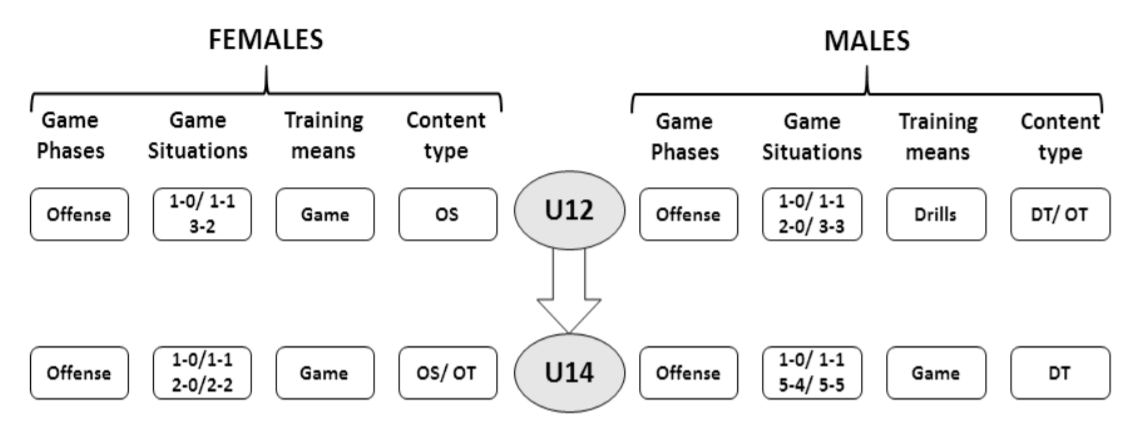
Moreover, Sánchez (2002) used in-depth biographical method to overview the basketball training system in Spain. He analyzed numerous biographies of the former successful basketball players and found common features among them. He argues that to develop a professional basketball player the training process should focus on players’ intellectual, physical, and psychological development.
Thus, he divided the development of the basketball player into three main stages. During the first stage (up to age 16) it is important to focus on the players’ technique, but it is necessary that players practice several different sports. During the second stage (age 16-20), the players should focus exclusively on the basketball training and games. At this stage, it is important that players have an opportunity to participate in top-level competition, and train and play with players of better technical and tactical quality. Finally, during the third stage (age more 20), players should have professional attitude toward the basketball and to perform additional training outside of the official training process (Sánchez, 2002).
The performance of the Spain in terms of basketball can be well summarized through the following table 3 that shows the main achievements of this country in the international championships from 1936 until nowadays.
Table 3. International Championship Participation and Awards of the Spanish Men Basketball Team from 1936 until today.
The table 3 shows that the national team of the country actively participates in the international tournaments on the regional and global levels and has good achievements in terms of obtained awards, which is the evidence of the success in this domain. In this context, it is also interesting to analyze the basketball performance of boys basketball team to examine the achievements of the youth in this sport.
Table 4. International Championship Participation and Awards of the Spanish Boys Basketball Team from 1964 until today.
The table 4 shows that the boys’ national team of the country actively participates in the international tournaments on the regional and global levels and has relatively good achievements in terms of obtained awards, which is the evidence of the success in this domain. It is also possible to see that the number of international tournaments for young males is relatively larger than the number of tournaments for the adult basketball players. In fact, it is a good sign, as the young men can not just compete on the national level, but also to see and feel the international competition, its reflection, its specifics, and its level. Comparing own play with the play of the foreign opponents provides many tools and possibilities both for personal and team growth.
Overall, it is visible that the youth training process is well-developed in Spain. Moreover, the coaches actively use the newest trends in the training process to get the highest outcomes from the players. Also, significant attention is paid for both the physical and psychological development of the players
Examination of Chinese Basketball Organizational and Training Systems
Organizational Structure of Chinese Basketball
Chinese sports management organization system consists of government sports management system and social sports management system. At the same time, the government sports management system has two subsystems: the government specialized sports management system and government non-specialized sports management system (Moya, 2018). Besides, a social specialized sports management system includes social organizations that are responsible for the sports management at all levels: the All-China Sports Federation, the Chinese Olympic Committee, and China Sports Science Association (Moya, 2018).
Talking about the basketball system, the basketball is organized and maintained by the Chinese Basketball Association. It represents Chinese basketball in the most prestigious international tournaments FIBA and FIBA Asia and is responsible for the promotion and development of basketball in the frame of the All-China Sports Federation. The current chairman of the Chinese Basketball Association is Yao Ming. Ming is a former NBA player and one of the most recognizable and famous Chinese athletes. He actively uses all his experience and professional connections to reform the Chinese basketball system and to improve basketball management, infrastructure, and marketing. The following figure 3 presents the possible visualization of the structure of the Chinese basketball system.
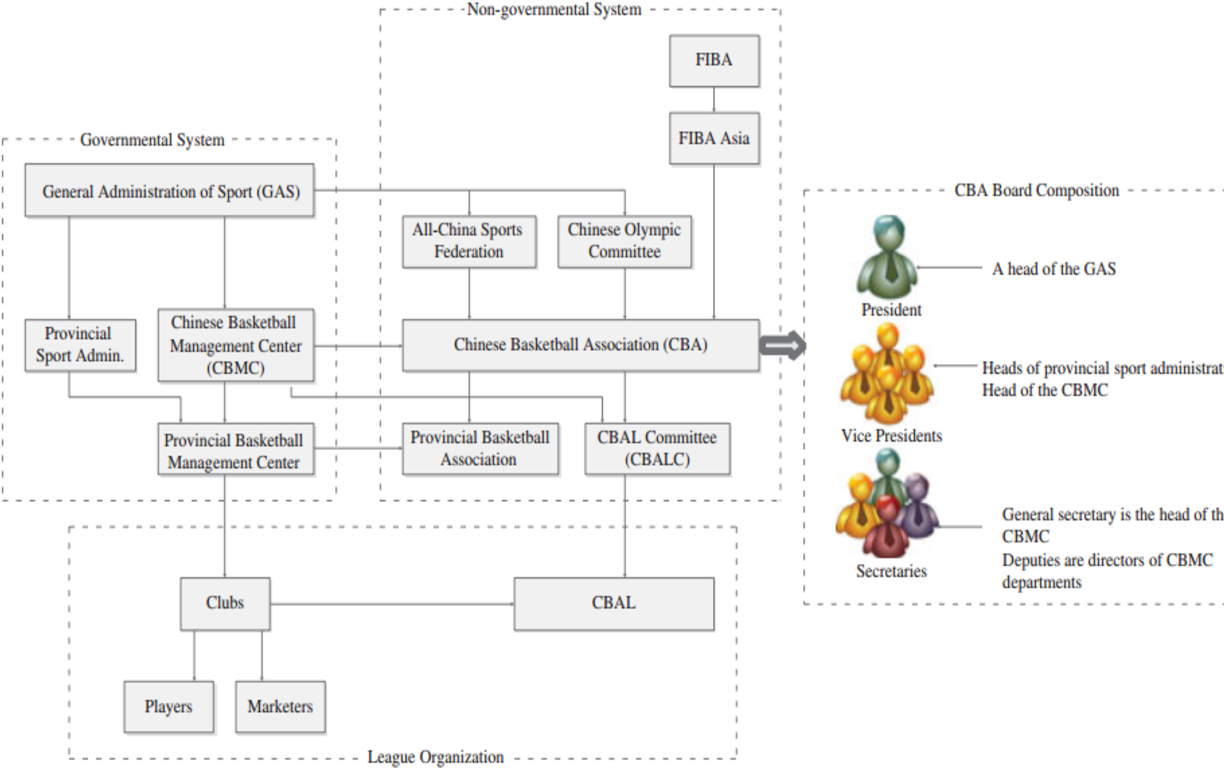
It is possible to see from the figure 3 that on the contrary to the Spanish organizational system, Chinese organizational system is very dependent on government and subsequent specifics of the country’s attitude to sport. The overlap between the governmental and non-governmental systems is constantly creating conflicts and challenges, as the country does not wish to marketize Chinese Basketball Association (CBA) League and it has negative consequences for the business side of the issue. According to statistics, in 2013 only five teams out of seventeen on CBA league could be profitable and only one of them managed to bring the profit of RMB 10 Million during that seaons (Chiu, 2017).
Selling the tickets is one of the key income sources for the Chinese basketball teams, however the latter do not have the power to decide on the schedule and the number of games in each season (Chiu, 2017). Parkway Jiaye (CBMC) makes the needs of the national team the priority and therefore deprioritizes the box office take of the CBA League. For instance, in the season of 2006 and 2007, there was around fifty days lay off out of the schedule of the league. It allowed the national team to prepare to the Asian Games in Doha in 2006 (Chiu, 2017).
The Chinese government has established five key economic strategies in relation to basketball. First of all, it generated many sources of income for the basketball systems with elite status. Secondly, they introduced a system of financial rewards (Tan & Bairner, 2011). Thirdly, they intervene in the transfer affairs of the players and try to control the Chinese Basketball Association. Fourthly, the Chinese government tries to manipulate the domestic professional leagues (for instance, Chinese Basketball Association League). The Chinese government has set the Chinese Basketball Association Management Office and Marketing Department in CBA to commercialize basketball (Tan & Bairner, 2011). After the country introduced the basketball system of capitalistic type, the national expenditures on basketball considerably decreased to several million yuan that were used directly to subsidize the Olympic squad and the national teams.
Consequently, the basketball systems in China started to be considerably dependent on the commercial incomes of the CBA and the commercial basketball clubs. However, when the government of China has established sponsorship and market mechanism to generate profits, it faced considerable challenge over priorities, between the national team development and the emergent commercial sectors. It also had to decide how to develop and deal with the basketball stars that are internationally mobile and the state controlled elite (World Championship and Olympics). Thus, the country established two organizations CBIDC within the Chinese Basketball Association under the General Administration of Sport’s supervision (Tan & Bairner, 2011). Through creating these institutions, the government of China managed from one side to generate the commercial incomes from CBA and from the other side to manage the national priorities.
To limit the “negative” influence of the commercialization on the development of China developed four important steps: (1) it limited the transfer fees that professional clubs could offer for their players and set the limit on salaries; (2) it created the specific procedure for dealing with the transfer market on the national level; (3) it established a control over the basketball association; (4) it established the control over the Elite Basketball Policy in the People’s Republic of China (Tan & Bairner, 2011).
Finally, the country established the main mission “Olympic and FIBA World Championship success first”, therefore the country has the right to intervene in the transfer of players and to shorten the CBA season to support the above-mentioned main mission (Tan & Bairner, 2011). According to Li Yuanwei (who is the director of CBMC) “The whole meaning of Chinese basketball is to enhance the profile of the national teams…Every club has to support and serve the nation’s teams without any conditions. The CBMC will use whatever resources we can to raise the profile of the national teams, regardless of the cost (Slusher, 2016)”.
Talking about ideological/cultural aspect, China has also established the ideological education to decrease the negative influence of commercialization and to avoid the leaking of the “national property” abroad. The Chinese government reemphasized the legitimacy of CBA ownership of all the basketball players registered in China. The main forms of the ideological education are teachings on revolutionary heroism, collectivism and patriotism to decrease the influence of money and materialism (Tan & Bairner, 2011). In addition, “to inspire” and “to discipline” the highly paid basketball players to work hard, the military training with the People’s Liberation Army of two weeks duration was established.
The ideological education was supposed to prioritize the national pride and to de-prioritize the personal interest. Such approach was supposed to prevent star players (for instance, Yao Ming and Wang Zhi-Zhi) from having a negative impact by promoting and embracing the global capitalist sport values, in particular, commercialism and individualism (Tan & Bairner, 2011). In other words, the Chinese government has showed not only the desire, but also the capacity to manage the impact of global basketball and has established the new agenda to defend own national interests through the renewal of policy capacity and the redefinition of the policy instruments. Tan and Bairner (2011) “the filters provided by domestic politics and political institutions play a major role in determining what effects globalization really has and how well various countries adapt to it (n.pag)”.
The performance of the People’s Republic of China in terms of basketball can be well summarized through the following table 5 that shows the main achievements of this country in the international championships from 1936 until nowadays.
Table 5: International Championship Participation and Awards of the Chinese Men Basketball Team from 1936 until today.
The table clearly shows that the country occupies the leading positions in the domain of basketball, especially on the regional level. In this context, it is also interesting to take into account the performance of the Chinese young males, measured through their participation in the international championship from the historical perspective until today..
Table 6: International Championship Participation and Awards of the Chinese Young Men Basketball Team from 1936 until today.
The table 6 shows that the Chinese youth male basketball team was not very active in terms of participation in the international events. However, the country approach is transforming and the state becomes more and more open and active on the international arena. The comparison of this table with the similar table that represents the participation of Spanish basketball players in the international tournaments in the previous subchapter demonstrates that Chinese young males participate in the international events considerably less. However, as it was previously stated the situation is changing step by step with the reformative approach of Yao Ming.
Basketball Youth Training in China
Not long before the 2008 Olympic Games in Beijing, Chinese focus their attention on the detection of talent and recruit children from the age of six, for their training centers. The main idea of this program utilized in different parts of the country is to detect the biggest natural talents. At the same time, the analysis of the scholarly evidence demonstrates that such approach is quite limited, as it does not take into account such important factors as external conditions, fatigue and competition. In the study by Bonal, Lorenzo, and Jimenez (2019), the author interviewed players concerning the factors that according to their point of view influence their performance the most. The scholars found out that there are eight key dimensions that play the key role for the basketball players (mentioned from the most important to the least important): social context, sport context, tactical factors, intra-individual skills, anthropometric factors, technical factors, physical condition factors.
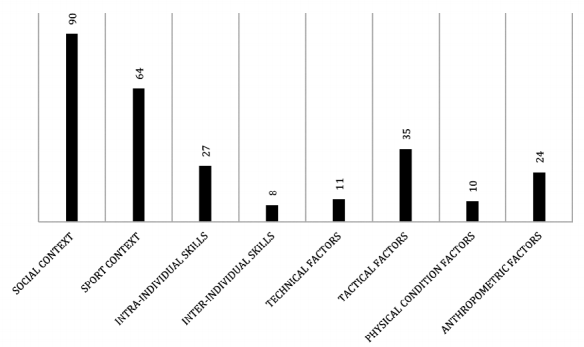
The elite players consider that abandonment of the studies to dedicate own life to professional basketball is a negative factor. Talking about sporting context, the Chinese basketball players describe their coaches as valuable positive figure for their development (Bonal, Lorenzo, and Jimenez, 2019).
However, the Chinese basketball players criticize their coaches for the excessive amount of training hours and poor structure of the training (Bonal, Lorenzo, and Jimenez, 2019). At the same time, the elite players in China consider that competing against foreign players and playing in the international competitions contributes positively to the development of their talent and to the enrichment of their tactical capacity. Finally, the cultural factors and their subsequent impact should be considered in all the talent development dimensions, since in the case of China they play very important role.
Zhang (2016) states that the basketball system in China requires significant transformation in order to ensure the competitiveness of it on the international arena and to ensure the sustainable development of this sport in the long-term perspective. Y proposes the range of the following necessary steps to reach the transformation.
First of all, the scholar proposes to deepen the system reform with the available innovate management system. To reach this Zhang (2016) states that the overall development and local propulsion are necessary to reach the sustainable development. Secondly, Zhang (2016) proposes to establish and promote the Organizations of the Basketball Association at all levels through strengthening the organization construction.
It is necessary to support the efforts, supervise, and increase the guidance of the associations of the county levels and below. Within this recommendation, the scholar recommends to organize different forms of basketball activities and competition from the grassroots level. Thirdly, it is recommended to promote the mass basketball, as “Trees grow high with solid roots, rivers flow far with abundant sources (Zhang, 2016, p. 405)”. Only using the approach of combination of education and sport can help to the development of basketball on the regional and national levels.
Currently, the plan of reforms for the upcoming years has already been outlined by Yao Ming. He has three main goals to achieve: (1) to increase the number of games and to divide the league into two conferences; (2) to shorten the period of training for the national team and to establish the system of invitation utilized by the NBA; (3) and to put restrictions on the court time of non-Chinese Asian players (Chiu, 2017). However, the officials of the CBA constantly state that the reforms of Yao as “not suited to China’s national circumstances” (Chiu, 2017). This justification is often used to dismiss transformative reforms viewed as too foreign by Beijing.
Factors that Influence Performance and Professional Growth of Basketball Players
There are many factors that influence the performance and the professional growth of the basketball players. Among the most important ones, it is important to mention the economic, political, cultural, and psychological factors.
Political factors
The politics and sport are very interrelated both on the national and on the international levels. This correlation is very well seen through the recent scandal with NBA in China, when the general manager of the Houston Rockets Daryl Morey openly supported the demonstrations in Hong Kong through Twitter (Wallbank and Cang, 2019). Later on the message was deleted and both National Basketball Association and Morey himself tried to distance themselves from it (Wallbank and Cang, 2019).
However, Chinese side took the situation very seriously, and the cooperation with the Rockets was suspended, while Tencent and CCTV stated that they would stop broadcasting all the team’s games. In addition, the editor in chief of the Communist Party newspaper “Global Times” Hu Xijin stated “Daryl Morey has the right to express his values, and Chinese fans of the Houston Rockets have the right to abandon this team (Wallbank and Cang, 2019)”. At the same time, the NBA has been considerably criticized in the United States for trying to please China at the expense of American values. This recent example clearly shows that sport is not independent, it is very related to politics. NBA has created and developed the relations with China for many decades, and one political controversy almost destroyed everything.
Economic factors
The economic factors play crucial role, as the material production level of the society determines the speed and the scale of the sports development. The amount of money the country assigns to basketball (for the development of infrastructure, the engagement of youth, organization of the development activities, hiring and training professional coaches, etc.) defines the popularity of the sport in the country and the success of its team compared to others on the international arena.
Cultural factors
The cultural factors also determine the flow of the basketball game, as national culture and national characteristics influence the players performance level. Actually, culture is a reflection of the connection between the national habits and the characteristics of basketball. To see how culture influences sport, it is interesting to go back to the times of the Communist China during Cultural Revolution (1966-1976) and the Mao Zedong rule. At that time, Western cultural products (including the competitive sports) were considered the reflection of evil capitalism that could spoil the purity of Chinese communism ideology.
However, luckily basketball was an exception and this game was not prohibited by the Party. This time is usually described in the following way: “Deprived of all forms of cultural enrichment and lacking the most basic athletic equipment, children and young adults roamed around their neighborhoods, setting up boards and hoops in alleys and courtyards and pouring their energy into the simple game of shooting the hoops. At that time, China had basically only two sports: basketball and ping pong. If you were young and loved sports, you only got these two to choose from (Gao, 2012)”. Still, through the destinies of the other sports during this period, it is possible to trace how culture and sport are actually interrelated.
Dietary factors
The dietary factor also impacts greatly the performance of the basketball players. The analysis of the traditional classical Chinese diet demonstrates that it is not very suitable for athletes, as it does not help to improve the athletic performance or the power of confrontation. At the same time, the European meat-focused ration with a lot of nutrients and animal proteins can help to enhance the physical fitness level of the sportsman.
Psychological factors
At the same time, the psychological perspective also encompasses a lot of factors (including awareness of yourself, physical feelings, emotional feelings, goals, visualization and confidence). Emotional feelings during training or games play very important role in the performance of the basketball players. External pressure, stress and lack of confidence surely impact the game of the basketball player in the short-term and in the long-term perspectives. Thus, strong mind and good mental health are very important things to have to reach success in basketball or in any other kind of sport. In addition, the awareness of ownself and emotional feelings during the games and trainings are also very important.
It depends how the player understands himself and how he calms down his mind. Understanding own strengths and weaknesses gives the opportunity to constantly improve and to contribute to the own and to the team’s performance. Comprehension how the basketball player feels physically is another important factor. It is necessary to understand and to know own body: what it can do and what it cannot do. Such approach would help not to be hurt and not to get injury either during the training or during the game.
Another important factor is technique. The time, the type and the specifics of the shooting technique defines the players’ success, as it develops the muscle memory helping the body to move instinctively, fast and smooth. Thanks to these instincts Michael Jordan managed to shoot a free shot with the closed eyes in the game against the Nuggets in 1991 (Retro Basketball Highlights, 2015). Similarly, thanks to the automatized technique, Stephen Curry managed to shot his three points with the block and the expiring shot clock in Game 2 of the 2018 NBA Finals (Forzano Productions, 2018).
In other words, the work on development of the technique contributes greatly to the success of the player and therefore of the team. Goals setting is another important factor. The performance of the basketball player depends on the short-term and the long-term goals that he sets, as well as performance tracking progress through simple measurement process (for instance, shooting 70% from the line of the free throw in nine months). In other words, it is difficult to measure the success if it is not defined.
The next important factor is visualization. For example, picturing oneself with wining shots and taking the ball from the opponent have the positive psychological effect, while visualization of loss and missed shots have the negative psychological effect. The basketball player should work closely with sport psychologist to trigger the activity of muscles through mental practice. At the same time, visualization helps to imagine some negative or challenging situation during the game and to think how to better deal with them. In other words, visualization helps to feel mentally sharp, confident and relatively relaxed when some challenging situations really become a reality.
Finally, talking about psychological factors, it is necessary to mention the question of confidence of the basketball players in his skills. The performance of the player significantly depends on the ability of the person to believe in own skill, to take the open shot, not to “freeze” from the nerves before and during the game. The confidence can be achieved through the physical and psychological preparation. On practice, it means perfecting the technique, getting in condition, overall hard work on own performance, and positive reinforcement from the coaches, teammates and other people, as well as getting some awards (for instance, trophies and medals).
The Functioning of the System
In the great majority of countries there is a great problem in the functioning of the basketball system, as many countries focus more on early detection of talents, instead of paying attention and developing the young players. In fact, the selection of talent only basing on his physiological and anthropometric criteria is not the right solution, since many factors impact the player’s progression to success (Ibanez, Saenz-Lopez, Feu, Gimenez, & Garcia, 2014). The analysis of the scholarly literature demonstrates that “An adequate formative process may favor the existence of new talented players that were not initially recognized as talented at very young ages (Ibanez, Saenz-Lopez, Feu, Gimenez, & Garcia, 2014)”.
Moreover, in order to be objective it is important to take into account the state of maturity and the growth of the basketball player and the pace of their development in the short-term and in the long-term perspectives.
Impact of Globalization on Development of Basketball
Globalization has significantly impacted the development of basketball sport all over the world. Thanks to large investments and titanic efforts in the past decades, NBA managed to bring the popularity of this sport to many parts of the world. According to Hancock (2013) “The universal appeal of basketball’s drama, intrigue and simplicity (a ball needs to go in a hoop) translates very well across many different languages and cultures in a way baseball and football never could (n.pag)”. In addition, NBA together with the countries’ governments contributed to developing the infrastructure and organizational system, improving the quality of competition, and popularizing and commercializing this sport among people of different age, gender and social background.
Also, NBA has significantly simplified their branding, therefore practically everyone can understand and identify with it. From one side, globalization of basketball means the popularization of this sport among the different populations and promotion of the healthy way of life on the global level. However, from the other side, globalization of basketball through NBA is a also a multi-billion industry with multiple revenue streams (from ticket prices to television rights, sales of jerseys and many other sources).
The impact of globalization is well seen through the analysis of the audience of the FIBA Basketball World Cup in 2019. According to statistics, its TV audience reach was more than 3 billion people, in addition to 1.5 billion video views on the social media. It shows the massive global popularity of basketball all over the world more than ever before (FIBA, 2019). The recent spread of Covid-19 would of course slow down the globalization of basketball in 2020, however when the situation stabilizes and returns to normality, the globalization would keep up with its previous pace of development.
Currently, China is leading in the world in terms of basketball spread within the territory of this country, however the evidence shows that India is a new target of NBA. Actually, NBA had a chance to test the incorporation, popularization and development of basketball in China and now with all this knowledge and experience, there is a chance to reach success in India much faster and with more efficient results.
Finally, it is important to state that even though basketball is really vital for the American culture, it means something more in the contemporary shrinking world. The NBA is similar to other businesses, therefore no wonder that similarly to the other businesses it seeks growth. The league adapts to the global marketplace and the practice shows that it is no longer dominated by the hegemonic American culture (Riches, 2013). It is important to state that the better understanding of globalization and the differences and similarities between countries and cultures can help Basketball Associations to fit better the context of the market, minimizing own weaknesses and maximizing own strengths.
Conclusion to Literature Review
The detailed analysis of the scholarly literature has demonstrated that even though a lot of scholars devoted their studies to the research of basketball in China and in Spain separately, there are almost no sources that compare these countries in terms of organizational system, efficiency, performance, coaching, preparation of youth, competitiveness, as well as numerous other important factors.
Thus, there is the scholarly gap in this domain that requires additional attention. Also, the research has demonstrated that the majority of the existing studies are highly theoretical and to certain extent, they are relatively far from practice and reality. Thus, there is a need of the research with the primary sources of information, as it could provide the important and practical data on the theme. Moreover, it is important to mention that there are almost no scholarly sources dating the years of 2019 and 2020. The basketball sport develops and transforms very quickly, therefore it is crucial to take into account the contemporary context and the most recent examples. Thus, the current research seeks to fill in the existing scholarly gap, using the methodology outlined in the following chapter.
Methodology
Goal and Objectives of the Study, Research Questions and Hypothesis
The main goal of this research is to make the comparative analysis of the basketball organization system in China and in Spain. Within this wider goal, the research has the following concrete objectives:
- to overview, present and compare the contemporary basketball system in China and in Spain;
- to examine and compare the strategy of coaching of the Chinese and Spanish basketball teams;
- to examine how the different relations between the basketball players and the coach they have in China and in Spain, and the relations within the team influence the performance of the players in China and in Spain;
- to determine the difference between China and in Spain about how to create self-development of male basketball player;
The main research questions of this research are the following:
- What are the common features and distinct features between the Spanish and Chinese Basketball Federations?
- What is the difference between the basketball organizational systems in China and in Spain?
- How does the training of basketball players differ in Spain and in China and how do these differences impact the performance of the basketball teams?
- How do self-development and motivation of basketball players differ among Chinese and Spanish players?
Hypothesis:
- In the U12 which younger age group, young players who have just been exposed to basketball training do not show a large difference in data. As the age increases and the various indicators of training gradually shows out the differences.
- The level of satisfaction with the basketball coach in terms of professional development, social and psychological support and training process is lower among the Chinese basketball players compared to Spanish basketball players.
Rationale and Explanation of Research Strategy
This paper uses mixed methodology, as it helps to better fit the objectives and goals of the current study. Generally mixed method research “draws on potential strengths of both qualitative and quantitative methods, allowing researchers to explore diverse perspectives and uncover relationships that exist between the intricate layers of our multifaceted research questions (Shorten and Smith, 2017)”.
It is difficult to explore and analyze basketball only with qualitative or only with quantitative tools, as such approach would provide more limited understanding of the theme. On the contrary, the mixed-method research provides more clear, profound and detailed picture on the analyzed topic. In other words, the mixed method research fits well for making the comparative analysis of the basketball organization system in China and in Spain. In particular, the main methods used within this research are interview, questionnaire and the secondary data analysis. The details on usage of each of the above-mentioned methods will be presented below.
Interview
Data Collection Method and Rationale
The author uses the structured interview of the representatives of the basketball federations in China and Spain to gather the information about the male basketball organization system in these countries. Generally, structured interview can be defined as “are fully controlled by the interviewer (who possesses much power) and as such, gives the interviewee less room to be flexible and casual” (Adhabi & Anozie, 2019)”.
The selection of interview method as a source of primary data was a well-thought, logical decision based on the range of arguments. In the beginning, one should admit that this method is appropriate for sports science, and sufficient theoretical information supports this thought. Thus, Smith and Sparkes (2017) acknowledge that “the interview is the most widely used method to collect qualitative data in the sport and exercise sciences” (p. 103). The rationale behind this suggestion refers to the fact that this tool is an indispensable source of new information about a selected topic (Smith & Sparkes, 2017). Simultaneously, researchers typically rely on interviews to collect qualitative data about people’s experiences and meaning (Smith & Sparkes, 2017). It is worth admitting that these positive outcomes can be achieved because individuals are conversational creatures, meaning that conversations are often used to share information and get new knowledge. Since sports research requires unique and essential data regarding what individuals think and feel, interviews seem the most appropriate methodology to be used.
In addition to that, the choice of the given tool relies on the fact that interviews promise to provide the paper with a few advantages. Firstly, the information on the male basketball organization system in China and in Spain is the theme that has not been vastly covered in the secondary sources. Therefore, primary analysis could be among the only ways to get the reliable, up-to-date and relevant information and to answer the set research questions. Secondly, structured interview allows interviewer to get prepared, to be competent, and to obtain meaningful information from the respondents. From the other side, it gives the interviewed person the possibility to express own opinion freely with the two way communication and the accompanying possibility to clarify issues and to pose additional questions, whenever it is necessary.
Some other scholars also admit the effectiveness of using the method under analysis. Interviews provide insights into individuals’ past events, present actions, and future imaginations that can help shape the present and future of sports and exercise (Chen & Chen, 2021). Selecting an effective interview method could be challenging because the value of information varies from one person to another, and deciding on an interview method that fits all participants could be cumbersome. A structured interview is very competent and effective in getting valuable information because of one-on-one communication between the researcher and the participant. In such an interview, the interviewer is obliged to follow the predetermined sequence and wording of questions (Adhabi & Anozie, 2017). With this approach, the interviewer is given a particular time to prepare. In the interview, the participant has the freedom to express their own opinions that counts.
The interview has been realized online through using Skype, Zoom or the other similar programs that allow video online communication. Before holding the interview, each Chinese and Spanish participant received an invitation letter that explains and clarifies why it is realized. The author has set the meetings with all the interview participants in the time comfortable for both parties. All the interviews were recorded, and then they were transcribed in the written form to simplify their further analysis.
Sample Size and Sampling Technique
The sample size for the interview is 20 people. According to Vasileiou, Barnett, Thorpe, & Young (2018), “the qualitative sample sizes are large enough to allow the unfolding of a ‘new and richly textured understanding’ of the phenomenon under study, but small enough so that the ‘deep, case-oriented analysis’ of qualitative data is not precluded (p. 148)”. The accent in these interviews is made to quality, not just quantity.
In particular, ten representatives of Chinese Basketball Federation and ten representatives of Spanish Basketball Federation were selected for the study. The convenience probability sampling was used to select the interview participants. The main requirements to be selected to the sample were: to have minimum three years experience and to provide the consent to present the detailed answers to all the set questions. The author of this research has found all the contact details of the representatives of the Basketball Federations in the Internet and sent them an email with an invitation to take part in the basketball-related research.
Approach to Data Analysis
The thesis utilized an appropriate and scientific approach to data analysis. There was a necessity to find an analysis strategy that could allow for identifying themes, topics, and patterns of meaning in a selected dataset of interviews. According to Braun et al. (2017), thematic analysis is a suitable approach because it helps researchers cope with these tasks. Since this approach does not offer any strict regulations as to sampling and data collecting procedures, scholars are given the freedom and flexibility to apply this strategy to sports research (Braun et al., 2017). The generalized theoretical assumption stipulates that thematic analysis is used for finding themes in data and “for describing and interpreting the meaning and importance of those” (Braun et al., 2017, p. 191). Even though the flexibility was highlighted, one still needs to mention that researchers should determine how they engage with the data. The given doctoral thesis relied on a semantic component denoting that the focus was placed on stated ideas and meanings (Braun et al., 2017). It was expected that this approach could contribute to a more accurate and reliable analysis.
Thematic analysis was also chosen because it suited the doctoral thesis. In particular, Braun et al. (2017) stipulate that this data analysis approach can be effectively used with interviews to receive an in-depth understanding of personal experiences. In addition to that, the researchers indicate that a generalized suggestion is that thematic analysis should include at least six interviews, but exceptions can also exist (Braun et al., 2017). Consequently, the given doctoral thesis meets the minimum requirement because it deals with 20 interviews. One should also note that this approach is suitable for beginner researchers and helpful in identifying key features of a large dataset (Nowell et al., 2017). Many factors allow for stating that thematic analysis is an optimal choice for the given paper.
It is worth admitting that thematic analysis should follow a specific structure to ensure that valid and credible results are produced. According to Braun et al. (2017), this approach implies a complex process consisting of “data familiarization, coding, theme development, revision, naming, and writing up” (p. 196). Each of these stages was present in the doctoral thesis, which allows for concluding that the thematic analysis approach was correctly utilized. In particular, the familiarization step implied reading over the interview transcripts two times. Over the third reading session, initial codes were assigned to essential data fragments that were of interest to the thesis. Theme development was the third step, and it implied gathering codes around more significant and broader concepts (Braun et al., 2017). Revision and naming, the fourth and the fifth stages, stipulate that the created themes were reviewed to ensure that they offered coherent data and that their names reflected the content (Nowell et al., 2017). Writing up was the final stage, and it implied creating the final analysis text.
Since a manual data analysis approach is not suitable for a doctoral thesis, an appropriate software application was used to deal with thematic analysis. In particular, Atlas.ti software version 22 (https://atlasti.com/) was chosen to analyze the data. This program helps researchers effectively deal with the qualitative analysis of large textual datasets, make necessary comments, and see the results. The rationale behind selecting this software refers to the fact that it can be easily and freely accessed. It is excellent that this computer program implies a sufficient free trial period to complete a thematic analysis of 20 structured interviews.
The data analysis was realized within several following categories: the main problems and challenges of basketball federations, the strengths of the basketball federations the development of basketball federations, the funding of basketball federations (including sponsorship, social fundraising, government grants), organization, promotion, management, development and support of the different social, educational, cultural and sporting activities for the benefit of basketball, support of the charity and social and humanitarian development programs through basketball, the impact of the President of the Basketball Federation on the development of this sport, promotion of basketball, differences in regional development, interest of the audience, talent acquisition and youth training approach, and attitude to NBA as a role model in basketball. These categories can be correlated and connected to the results of the questionnaire and the secondary data analysis, helping to test the hypothesis and to answer the main research questions.
When the semantic analysis was completed, a comprehensive approach was undertaken to uncover and interpret the meanings of the interviews. This task was completed by considering the interviewees’ answers to the predetermined questions and commenting on them. It is possible to state that these efforts contributed to a more comprehensive analysis of the collected data. On the one hand, the Atlas.ti software allowed for identifying the main themes of the interviews. On the other hand, the detailed consideration of individual answers contributed to revealing the true meanings of the interviewees. The combination of the two approaches led to receiving sufficient and valuable data to answer some of the research questions.
Questionnaire
Data Collection Method and Rationale
The author uses the questionnaire to gather the information about the male basketball organization system in China and in Spain. Generally, questionnaire can be defined as “a set of questions for obtaining statistically useful or personal information from individuals (Merriam Webster Dictionary, 2020)”. In particular, the close-ended format of questionnaire is used, meaning that the respondents chose the answers among the existing proposed variants. The questionnaire has been selected as a research tool due to the range of important strengths of this method. First of all, questionnaire allows examining the large amounts of information from the large amount of people (Prasad-Nayak and Narayan, 2019). Secondly, the realization of the questionnaire can be realized in the cost-efficient and fast way (Prasad-Nayak and Narayan, 2019). Thirdly, the analysis of questionnaire can be done with simple and efficient quantitative tools to demonstrate the correlations between the concepts and their impact on certain issues (Prasad-Nayak and Narayan, 2019). Thus, all the above-mentioned strengths prove the rationale of using questionnaire in this research.
The author of this research has utilized the free online tool SoGoSurvey, as it is a reliable, secure and affordable platform to conduct a survey that allows automatisation of the categorization of the research results. The participants got the link to participate on their email address and had two weeks to answer the questionnaire. After two weeks the author of this research has started to analyze the research results.
Sample Size and Sampling Technique
The sample size for questionnaire is two hundred people: 100 Chinese male basketball players and 100 Spanish male basketball players. The purposive non-random sampling will be used for selecting the questionnaire participants. This type of sampling is usually used to produce a sample that can be logically considered to represent the population. According to Lavrakas (2008), it is achieved through “applying expert knowledge of the population to select in a nonrandom manner a sample of elements that represents a cross-section of the population (p.1)”. The basketball players for the questionnaire were selected from the pool of the teams headed by the interviewed coaches. Such approach allows seeing ‘the two sides of the coin’ (the opinion of the coach of the basketball players and the opinion of the basketball players of the coach). To ensure that the target basketball players have equal probability to be selected, the author has divided the basketball players of each country on four groups (U12; U14; U17 and other). The author has obtained the contact details of the basketball players from the coach (upon their agreement and wish to participate in the survey).
Approach to Data Analysis
To analyze the results of the survey the author used the comparative analysis. It helps to compare the responses of Chinese and Spanish basketball players or to compare the responses of the same country in different age categories. In addition, it assists to contrast and connect the questionnaire results, the interview results and the results of the secondary data analysis. To demonstrate the results of the questionnaire of two hundred people, the diagrams were be used. They visualize the responses of the participants and simplify the comprehension of the research results. The data analysis was realized within several following categories: relations between basketball player and the basketball coach, relations between basketball player and his teammates, the level of individual and team performance during the training, self-development of the basketball player, level of satisfaction with country’s basketball development, level of competition between the teams in the basketball league, and basketball players self-perception of skills. These categories coincide with the categories used in the interview and the secondary data analysis, leading to the better comprehension of the theme and to answering the key research questions.
To ensure the validity of the questionnaire method, the pilot questionnaire has been conducted. According to Sincero (2020) “A pilot survey also tests the correctness of the instructions to be measured by whether all the respondents in the pilot sample are able to follow the directions as indicated. It also provides better information on whether the type of survey is effective in fulfilling the purpose of the study (n.pag)”. In particular, ten pilot questionnaires (five of Chinese basketball players and five of Spanish basketball players) were realized before making full-scale questionnaire. They showed the relevancy of the questions in the survey for the current research and demonstrated that the data-analysis tools are appropriate.
Reflections on the Limitations of Questionnaire Method
The questionnaire method has certain limitations. The first limitation is dishonest answers. The basketball players may feel afraid or confused to describe truthfully their relations with the coach and with the teammates. To avoid this, the author ensured them that all the answers are totally anonymous and they will not be shown neither to the coach nor to the teammates (all the results of the questionnaire are presented in the summed-up form for all the age categories in the respective countries). The second limitation is random answers and lack of understanding of the importance of the theme. In order to ensure the truthful engagement of the participants, the author of this research has created an introduction to the questionnaire which clearly explains why the questionnaire is realized and how the results will be used.
After reading this introduction, the participants are supposed to comprehend its significance and to provide truthful answers, seeking to contribute to the development of basketball in their country and in their community. The third limitation is interpretation issues, meaning that the information may be wrongly interpreted. To avoid this, the author of this research has carefully designed the questions and the possible answers. It could help to minimize the misinterpretation issues. Finally, another important limitation is survey fatigue. The survey has only 12 questions, which cannot be considered as long enough to cause the survey fatigue. Thus, it is possible to state that the limitations of the questionnaire method do not prevent the author from realizing the high-quality research.
Secondary Data Analysis
The secondary data analysis is realized in the literature review section of this thesis. It helps the author to overview what has been researched by the other scholars and to compare and contrast it with the results of the primary data analysis. The literature review takes into account only the scholarly and reputable sources published within the last ten years to ensure the validity and applicability of the research results. The author used mainly the Google scholar database, the official websites of Chinese and Spanish basketball federations and the interviews with the specialists in the domain of basketball to get the information on the research topic. The information from Wikipedia, internet forums and other similar sites was not taken into account, as the reliability of such data is questionable. The data analysis was realized around the following concepts: organizational structure and basketball youth training in Spain and in China, and the factors that influence the professional growth and performance of the basketball players. These results of the secondary data analysis can be correlated with the analysis of the concepts from the primary sources (the interview and the questionnaire).
Ethical Issues
This thesis is realized with the respect to all the ethical requirements, required for such type of academic work. The author of this research was guided by the ethical guidelines provided by the study of Vanclay, Baines, & Taylor (2013): “respect for participants, informed consent, specific permission required for audio or video recording, voluntary participation and no coercion, participant right to withdraw…no harm to participants, avoidance of undue intrusion, no use of deception, the presumption and preservation of anonymity, participant right to check and modify a transcript, confidentiality of personal matters, data protection, enabling participation, ethical governance (p.251)”.
Both the interview and the questionnaire participants signed the informed consent form. The informed consent shows that people participate in the questionnaire and in the interview on the voluntary basis. This document also shows that all the personal information of the participants will be kept confidential and will not be disclosed to the third parties. The author of this thesis has reflected the respect to the participants and ensured the satisfaction of the “no harm” principle. In addition, this thesis is free from “writing misbehavior”, meaning that there is no plagiarism (as all the external sources are cited according to the rules of APA style) and there is a clear effort of the author to be objective and not to misinterpret information.
Presentation of the Results
Presentation of the Results of the Interview
The Atlas.ti software allowed for performing the thematic analysis of the ten interviews with representatives of the Spanish Basketball Association. After the transcripts were read over two times, the coding process took place. Sixteen codes were obtained, including Popularization Efforts, Strengths, Current Development, Further Development, COVID-19, Income, Structure, Talent Acquisition, President’s Contribution, Basketball Federation’s Contribution, Regional Variations, Charity, Weaknesses, Lack of Popularity, External Support, and Good Coaches. These words and word combinations represent the topics that were covered in the interviews, and a total of 202 quotations were selected.
It is worth admitting that the codes were not equally distributed among the interviewees, meaning that respondents drew more attention to some topics and ignored others. For example, the Popularization Efforts and Strengths were the most frequent codes since 23 quotations represented each of them. Simultaneously, two excerpts were only included in each of the External Support and Good Coaches codes. In fact, Graph 1 below illustrates the distribution of the codes and the exact number of quotations in the selected dataset. The visual element can help understand the accurate picture of the obtained results to understand which topics were more popular and which ones did not receive much attention.
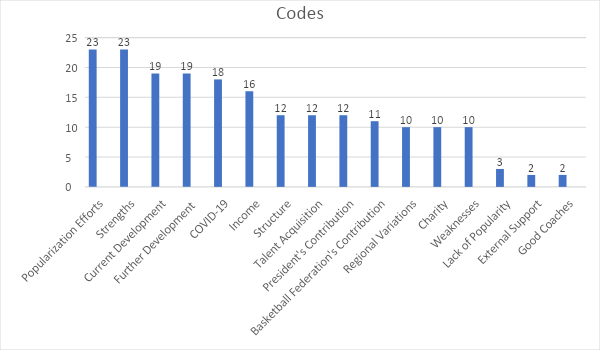
Theme development is the second step of the thematic analysis, and it means that it is necessary to group narrow codes around broader concepts. According to the identified quotations, the first suggested theme refers to the positive features of basketball development. This topic comprises many sub-topics, including Strengths, Income, Structure, Charity, External Support, and Good Coaches. In a similar fashion, the second theme represents the negative features of basketball development. This concept focuses on COVID-19, Weaknesses, and Lack of Popularity. The third topic refers to the explanation of how basketball is being developed in the country. This topic covers many codes, including Popularization Efforts, Current Development, Further Development, Talent Acquisition, President’s Contribution, Basketball Federation’s Contribution, and Regional Variations.
The revision was the fourth step of the given thematic analysis. During that stage, significant efforts were applied to compare the interviews against the obtained themes. The process was utilized to make sure that the content was in line with the identified subjects. For that purpose, all the ten interview transcripts were read over once again and checked against the three themes. This stage did not reveal any inconsistencies, and it was decided that the created themes perfectly reflected the content of the interviews.
The fifth stage implies that it was required to create names for the themes. Since the first topic represented positive features of basketball development, the Advantages were the suggestion. One should state that the given topic consists of many concepts, including direct presentation of strengths, various income sources, structural peculiarities of the current basketball system, charity activities, support from external organizations, and coaches’ performance. Disadvantages were the second theme, and it covered COVID-19 consequences, direct comments about the existing weaknesses, and insufficient popularity of basketball in the country. In other words, this topic focuses on all phenomena and processes that adversely affected the development of basketball in Spain. Finally, the third theme was the broadest one, and it considered how the basketball system was governed, what structural peculiarities it had, and what future directions existed. That is why the suggested name for the third theme was Development Processes.
The analysis of this data demonstrates that the third theme was the most popular in the interviews. In particular, 106 quotations represented the topic of Development Processes. The Advantages created the second most frequent theme because 65 separate quotations were included. Finally, 31 excerpts made the third topic, Disadvantages, that focused on the existing weaknesses. The comparison of the three themes demonstrated that Disadvantages were the least frequent topic, which allowed for concluding that not many weak points affected Spanish basketball. However, such a simple approach to the data does not reveal what the interviewees meant and how they described basketball development in their country. That is why the detailed consideration of the individual answers was performed, and its results are presented below.
While answering the first question on the general development of basketball in Spain, all the interviewed people stated that the level of development is very high, while also acknowledging the need for improvement in many aspects. Interviewee #2 mentioned the relative nature of the development. For instance, compared to the countries of the Middle East or Africa, the level of basketball development in Spain is very advanced. At the same time, compared to the United States, the level of development could be improved. Interviewee #3 stated that to see the real situation, the words do not matter much and it is necessary to see the statistics.
In particular he stated: “See the official statistics on the performance of Spanish basketball teams in international tournaments, see the amount of talents that our country produces and you will understand the level of development of basketball in Spain”. The interviewee #4 mentioned that development of basketball is something that continuously changes, however currently Spain has one of the best teams in European basketball, and the Spanish league is considered as one of the toughest in Europe. Interviewee # 5 supported this opinion stating that “We have the best specialists, the best players, and almost everything we need to be successful”. The representatives of the Basketball Federation acknowledged that it is impossible to reach the ideal, but stated that they are trying hard to do so.
The interviewee #7 stated that the Basketball Federation of Spain has no illusions concerning the popularity of this sport and the fact that it is much less popular than football. However, he also acknowledged that basketball has great potential in Spain in the upcoming decades. Interviewees #8 and #10 acknowledged the long-term commitment to excellence of the Federation and continuous development of basketball: “Today our results as Federation are better than 10 years ago, than one year ago and even than yesterday. If you imagine and exemplify our performance with the graph, you will see that our performance line constantly goes up from the down. To explain the high level of development, the interviewee #9 stated that it can be explained by the good performance and cooperation between the Basketball Federation, clubs, coaches, managers, methodists, and journalists at all levels (starting from the mini basket and finishing with ACB clubs and national teams).
While answering the second question, all the respondents agreed that the Basketball Federation of Spain is facing numerous problems and challenges. The interviewee #1 mentioned the problem of lack of popularity of basketball within the country, compared to football. At the same time, the interviewee #2 stated that it is difficult for the Basketball Federation to adapt to the contemporary reality and that youth today is totally different from the youth 25 years ago, as they perceive basketball in a different way and they use screens much more in their lives. He also stated that basketball today is not only a game, but a commercial product that should be sold according to the rules of the market and it is quite challenging for Spain.
Many of the respondents also mentioned the spread of COVID-19 as the main problem, as the international tournaments and championships are cancelled or postponed, people are afraid to visit the games due to the crowds, not even talking about the economic problems of the sponsors. COVID-19 has put all the other problems far away. Many interviewees also mentioned the financial problem, as to be the best, it is necessary to invest a lot. In other words, the financial side shapes and defines all the other factors: “The more money you have, the more professional people you can hire, the better infrastructure you can create, the more you can invest in the development. In this context, the respondents also mentioned that only the top players make it enough not to worry about it, while on a lower level players sometimes need to search for another job in between the seasons to make the living.
Another problem of Spanish basketball discovered during the interview is the need of audition, which would allow to better understand the preparation of youth, to communicate with fans, and to better engage with everyone interested in basketball. The audition would also give the opportunity to better administer and manage the system, as well as to organize finances more efficiently and to reduce bureaucracy. The other problems mentioned during the interviews was the lack of the unified and clear vision of development with coaches, the players’ unions, ACB, the Olympic Committee, and FIBA, as currently there are too many differences in understanding of basketball. Finally, the interviewee #8 stated that it is necessary to strengthen the lower leagues and to provide them the room to grow and to compete, as there is the situation when the young promising basketball players that can show very good performance have no possibility to play, because there are too many foreigners.
While answering the third question, all the respondents agreed that Spain has many strong sides in terms of basketball. For example, interviewee #1 stated that one of the main advantages is the ability to develop own star players instead of hiring people from the other states. Such system encourages the development of talents, the growth of the players and the good performance on international arena. At the same time, interviewee #2 claimed that the main strength of Spanish Basketball Federation is the efficient organization of basketball administrative and organizational process that encourages and promotes the development of basketball within the country. He also mentioned that the Basketball Federation managed not to create barriers, but to create opportunities and this is a great achievement. The interviewee #4 also supported this opinion stating that “the success of Spain on the basketball court is mainly shaped by the development of the players, the ways the coaches teach the game, and the approach to personal growth of the player.
Yes, all the countries try to develop the basketball players, but Spain does it in a remarkable way”. The respondent of the third interview mentioned that Federation has very transparent structure and functioning, free from corruption or hidden influences. At the same time, the interviewee #6 mentioned that the key strong side is the ability to learn on own mistakes, to acknowledge the problems, to solve them and to learn on them. To exemplify own words, the interviewee stated that “…in 2016 we had around three million Euro deficit, however today we managed not only to cover this deficit, but also to earn money for our organization. We constantly try to improve and never ignore the problems whatever they are”. Finally, the respondent #9 believed that the main strengths are the coaches, that they are very good professionals and they constantly visit the other countries and watch the changes and trends of international basketball. He also mentioned that they visit mainly the United States, as they still have a lot to learn from NBA. Learning on the experiences and mistakes of the other countries, the coaches provide exceptional basketball education of the Spanish basketball players.
While answering the fourth question, all the respondents agreed that the Basketball Federation of Spain actively participates in the organization, promotion, management, development and support of different social, educational, cultural and sporting activities for the benefit of basketball. For instance, respondent #1 stated that the Federation tries to communicate with community and to interact with it in different ways: “Our employees visit schools and even kindergartens to show our presence and to demonstrate that basketball is interesting, engaging and promising sport both for fans and for participants”.
In addition, respondent #2 stated that Basketball Federation actively cooperates with many NGOs and social organizations on the national and on the international levels. They help the institution significantly in the organization of all the social, educational, cultural and sporting activities. Respondent #4 also mentioned that Basketball Federation of Spain supports basketball social activities that promote teamwork and healthy lifestyle. For example, they cooperate with CID Casa de Murcia – Getafe and Tres Cantos Basketball Club to promote the sporting and recreational activities for people that have intellectual disabilities. Also, they work a lot with the wheelchair basketball team. At the same time, respondent #5 stated that Basketball Federation tries to organize a lot of health promotion events to demonstrate the youth that basketball is interesting, engaging, fashionable and healthy activity.
They try to educate youth, to help them to acquire the healthy habits and to make them admire the basketball stars. In other words, the Basketball Federation tries to guide the young people in the right direction. The respondent #6 also acknowledged the tight cooperation with FIBA in terms of organization of different social, educational, cultural and sporting activities for the benefit of basketball. For example, they have the initiatives to help the poor and disadvantaged youth. Through basketball they wish to show them that there is an alternative to the dangerous and often criminal street life. They also wish to show that hard work always pays off and what really matters are not the money, but the efforts to achieve the dream. Their goal as a Basketball Federation is not only to help the national teams to get medals and prizes on international competitions, but also to help the Spanish society to be healthy, the Spanish children to be sportive. They wish to motivate and inspire people through basketball in different possible ways.
Also, the interviewee #7 stated that the Basketball Federation in general and basketball players in particular take into account the current context of Covid-19 pandemic. For example, recently Pau Gasol started the campaign called “This Medal is Yours”. It seeks to raise money and to help people in the times of health emergency to overcome the crisis. Marta Xargay from the women’s national team and Javier Beiran from the men’s basketball team joined the campaign and donated their medals to Red Cross to fight with the negative consequences of COVID-19.
While answering the fifth question, all the interviewees stated that the Basketball Federation of Spain managed to secure the stability of the main resources through sponsorship, social fundraising, and government grants, etc. At the same time, even though the financing of the institution is constantly evolving and changing, it is trying to get as much resources as it is possible. For example, the main subventions of Spanish Basketball Federation in 2017-2019 were from European Union, Diputazion de Cadiz, Ayuntamiento de San Fernando, and Fundación Tripartita. The main sponsors of the country’s Basketball Federation are Nike, Finetwork, Caixa Bank, Endesa and many official sponsors, such as Iberia, SantaLucia, Finisher, the Travel Brand and many others. At the same time, the basketball for disabled is financed by other institutions, such as Consejo Superior de Deportes and Organización Nacional de Ciegos Españoles.
Another form of funding that Federation actively uses are the broadcasting rights. For example, they cooperate with Cuatro TV Channel and Teledeporte for the broadcasting of men’s and women’s national basketball teams. They try to follow NBA model in terms of funding. In the United States, basketball is not just a game, but a very profitable business: “We try to change the funding model of the basketball into American one to be less dependent on government support, and more dependent on personal performance and marketing”. The Basketball Federation tries their best to ensure the growth of the funding, but COVID-19 made a big negative impact. It will be necessary to find the new approaches to funding, as the current system does not work very well.
While answering the sixth question, the respondents stated that the Basketball Federation actively supports charity, as well as social and humanitarian development programs through basketball. Some of the basketball clubs have their own charity projects and programs. For instance, Real Madrid developed a charity to fight with the spread and consequences of Malaria. The basketball player Pau Gasol has own foundation called “Gasol Foundation” that promotes health and wellness of the body in the partnership with UNICEF. For example, he gave $10,000 to UNICEF to help building safe schools for children in Africa.
Or after a typhoon devastated the Philippines, he pledged to donate $1,000 for every bucket he scored in a specific game. The most recent charitable program of the Spanish Basketball Federation is focused on the fight against COVID-19. One of the respondents also mentioned about the program called “Basketball without Limits”, which is actively used in around seven Spanish women’s prisons. It is like a psychological help to prisoners that helps to establish the healthy lifestyle and habits and that helps to maintain and learn discipline. To some people, it even helps to find the meaning in life. At the same time, the interviewee #5 mentioned that the institution has developed the continuous partnership with the Spanish Association against Cancer, visiting schools to inform the kids on the importance of leading healthy and active life. In his turn respondent #6 stated that each year, the Federation participates in some way in the family day. They organize different basketball related activities with parents and their children.
They practice different forms of engagement, including basketball, face art, bouncy castles, etc. This participation is very important, as through it they build the connection between generations. The respondent #7 and #8 also stated that Federation understands its social mission and cooperates with different social centers to help the disadvantaged children to find the meaning in life through the sport. Basketball helps such children to learn discipline, organization, and healthy lifestyle. At the same time, interviewee #9 stated that the Basketball Federation continuously raises money and tries to support the vulnerable parts of the population with these funds.
While answering the seventh question, the respondents provided different answers regarding the possible transformation or change that is the most important for the Spanish Basketball Federation and regarding its short-term and long-term goals. For instance, interviewee #1 stated that there is no need to change, but just to further expand and develop the existing projects. According to his opinion the short-term goal would be to win the upcoming international tournaments and the long-term goal is to maintain the winning positions. At the same time, the respondent #2 stated that the short-term goal would be to tackle the consequences of COVID-19 and to get back to the normal sportive routine at all levels.
The interviewee #3 stated that it is necessary to work on the weak sides and in this way in the ten year period, Spain will not follow the international trends in basketball, but will set them. In his turn the respondent #4 stated that when we are talking about the long-term goal, it is about overcoming the NBA and gaining the top position in the world basketball. He also stated that the most important is to develop the structure of basketball, support the players, organize team buildings, lower the level of taxes, which the players have to pay, providing as much promotion as possible, so more people could find out about the clubs and, of course, provide place and facilities for the players. The interviewee #8 proposed to hire more people to better develop the basketball players of all ages. He believes that more coaches, more doctors, more volunteers, more mentors would bring the positive change to the basketball system of the country. Of course, the question is not only about quantity, but also about quality and professionalism of the specialists.
At the same time, according to the interviewee #9 the main transformation that should be realized is the computerization of the games, similarly to NBA. The computerized systems, such as Noah, RSPCT, and HomeCourt are very good for evaluating the shots of the players and they provide plenty of useful information. In addition, computers allow achieving greater objectivity. Finally, the respondent #10 stated that the Federation has failed to comprehend that the time flies and what has been efficient ten or five years ago is no longer efficient. In other words, the times are changing, the people are changing and therefore the approaches to them should also change and transform. The Basketball Federation needs to evolve and to transform with the flow of time. In ten years period, they hope to be the champions of the world and they try to overcome the United States in this sport, but the results depend on multiple factors.
While answering the eight’s question on the impact of the President of the Basketball Federation on the development of this sport, all the respondents agreed that the current president Jorge Garbagosa is completing the work well on his position. In the course of history, Spain had different presidents of the Basketball Federation. Each of them had own advantages and disadvantages. According to the point of view of the respondent #1, the current president is very professional and strong, as thanks to his reforms the state showed very good performance and the results of the international competitions are the proof of it.
At the same time, the respondent #2 stated that the role of president is important, however he never works alone and it is necessary to acknowledge the role of the other people on the lower levels which work every day to transform Spanish basketball for the better. Still, the president is very professional, since he ensures the strategic thinking and good professional experience. The respondent #4 stated that the role of the president is very important, since it is both symbolic and functional. He fulfills his duties very well, helping basketball in our country to grow and evolve. The respondent #6 stated in relation to this question: “I evaluate his works positively. Everyone can see that he is not a bureaucrat that senselessly sits on his official position. His efforts are visible and measurable. I never heard any negative feedback about Jorge during my career”.
For many years, it has been one of the key objectives of the Basketball Federation to develop the national basketball team, as it represents Spain on the international arena. Almost all the respondents also agreed concerning the answer to the question concerning the contribution of Basketball Federation to the development of the national basketball team. Overall, the interviewees showed that Basketball Federation helps the national basketball team to reach its goals, serving as a mediator and an administrator and contributing to many aspects, including: financing, development of players on physical and psychological levels, promotion of teambuilding and team spirit, and hundreds of other issues.
They try to create very favorable and comfortable conditions for the national team to satisfy their needs and wishes to the maximum. It seeks to help to reach maximum efficiency of the players and to achieve the best results. Currently, they plan to invite Pau Gasol to coach the male national team, however they are still on the stage of negotiation and communication. Currently, the Basketball Federation cooperates with Sergio Scariolo (men’s coach) and Lucas Mondelo (women’s coach), both of whom are wonderful specialists who help the national teams to show good performance. The interviewee #7 stated that he believes that the success of the basketball team happens not only thanks to the efforts of the basketball players, but thanks to the hard work and efforts of the whole Federation of the country.
The representatives of the Basketball Federation did not have the same opinion concerning the promotion of basketball development within the country. For instance, interviewee # 2 stated that they plan to use the adapted NBA model for the popularization of basketball in Spain, to cooperate with the sponsors and to organize some events together for the benefit of both. He also stated that “Until now, such cooperation always brought positive and measurable results, but now with all this economic and financial recession on the global market due to COVID-19, I think we will have to cancel a lot of events scheduled with our partners and sponsors”.
At the same time, respondent #3 stated that they have a lot of plans, especially the ones related to the social media, as the latter plays very important role in the social, personal and educational life of contemporary youth. The interviewee #5 supported this opinion and stated that Federation has launched official accounts in the most popular social media. Thus, people can read the latest news and to see the latest results in more comfortable and easy way. In this context, the interviewee #7 stated that they are planning to use more actively Facebook, Instagram, Twitter, TikTok, as well as other social media and Internet tools (bloggers and influencers) to promote the development of basketball within the country. In addition, they plan to organize many popularization events to engage with youth and their parents all across the country. At the same time, the respondent #4 stated that the Federation is working according to the plan and doing their best to promote the basketball development, which includes wide range of different activities from cooperation with schools and work with youth to organizing events and advertising through different media channels.
In his turn, respondent #9 claimed that to increase the popularity of basketball development, it is necessary to promote the mini-basket, as this game can be played by practically everyone and you can have simple facilities to play it. The more people all over the country would play basketball, the better. Finally, the respondent #10 stated that even though they have many plans, almost all of them are related to the financial factors. In the course of the last years they managed to decrease the dependence from state funding and became more independent, however Covid-19 had very negative influence on us and they still do not know how everything would turn out for them . Thus, in the context of Covid-19, their plan is to reorganize the existing basketball system, to increase the accessibility of this sport and its popularity for the population in general and for the kids and youth in particular.
While answering the question concerning the regional development of basketball in Spain, all the respondents agreed that compared to the other countries the differences in regional development are not very visible. For instance, the interviewee #2 stated that Spain is “among the few countries, where the level of basketball development is more or less equal across all the territory of the country from the West to the East and from the North to the South.
I do not think that differences in regional development of basketball are now a great problem of the Basketball Federation of our country”. The respondent #3 agreed with such opinion, stating that the basketball is strong in different cities of the country: in Barcelona, in Madrid, in Murcia, in Valencia, in Bilbao. The interviewee #6 also stated that recently, the teams of Seville, Palma, Palencia, Granada and Bilbao showed tremendous equality. It is possible to see in the ACB that the strongest teams are Barcelona and Real Madrid, so it is possible to assume that these cities are the most developed in terms of basketball, but the cities of the teams Baskonia, Joventut, Malaga, Estudiantes, Valencia, and Gran Canaria also show high-level performance and the competition between the teams is really tough. It is possible to see that the popularity among people across the country is also growing steadily. For instance, the following statistics shows that regional differences are not very big problem: “The visiting of Granada team games reached around six thousand people audience.
In Palencia, around five thousand people visit the games of the city’s basketball team. The pavilion of Bilbao regularly gathers around seven thousand people”. However, the interviewees also do agree that there are things to improve in terms of regional development and that they are working on that. At the same time, the respondent #4 stated that even though in many countries of the world, basketball sport is better developed in the big cities. Of course the Federation tries to minimize the gap as much as possible, however it is inevitable tendency due to many social and economic reasons. The Basketball Federation tries to provide everyone equal opportunities, however there is only one way to tackle the difference in regional development – to invest in weaker developed parts to make them stronger.
When answering the question concerning increasing the interest of the audience (spectators) to basketball within the country, the interviewees had different opinions. The respondents stated that the Federation regularly participates in the different sporting and “healthy way of life” events and until now such approach brought quite positive results. People see them, get to know them, allowing engaging and popularizing the sport among the people. At the same time, the interviewee #2 stated that they plan to use the adapted NBA model for increasing the interest of the audience to basketball in Spain. He believes there is no need to reinvent the wheel, and it is good to use the existing practices. They plan to cooperate with government to promote the development of basketball within the country at all levels, as the state has the necessary tools that could help the promotion of this sport among the youth. The interviewee #3 stated that they plan to invest in marketing for popularization of basketball. The marketing covers many aspects: advertising on the streets, in the social media, on TV, etc.
He believes that today Instagram and influencers have a really big power for youth so they should actively cooperate with them. For example, he states that LeBron James has more than forty million followers on Twitter, not even talking about the other social media, like Instagram and Facebook. In contrast, Pau Gasol has one and a half million followers. Thus, it is necessary to develop and promote own basketball stars and to help them to become influencers. In this way, the Spanish youth will adore Spanish basketball players, instead of only NBA stars. At the same time, the interviewee #7 stated that the goal of the Basketball Federation is to make basketball as popular as football. Thus, when the person asks the small Spanish children of around 6-7 years old, who they want to be when they grow up, it is very likely they will tell that they want to be the famous footballers.
Football is famous and football is trendy, but basketball is also becoming famous. Thus, it is a priority to make basketball trendy and engaging sport in the eyes of the youth. At the same time, the interviewee #8 claimed that it is necessary to increase the popularity of basketball at all levels: “People should play basketball at the streets, read the basketball news, watch basketball on TV, visit the basketball games, support their favorite teams, etc. The only way to reach it is to give the love to the basketball from the early childhood”. Thus, the children and youth should be the focus of the Federation in the upcoming decade in terms of activities.
In this context, the interviewee #9 stated that it would be good to involve the advertising agencies. They are professionals in advertisement and in increasing the interest of the audience, therefore it would be nice to develop the marketing campaign together. The traditional methods are not working well, as the people today are different in mind and visions from the people of the past. Finally, the interviewee #10 stated that the only possibility to increase the interest of the audience is to interact with people and to show them that the game is engaging. Overall, people in Spain like sport, it is necessary just to show them the potential of basketball and “to educate” the audience. People may become the continuous fans if the way to their hearts and minds is found.
While answering the question on the main sources of income for the basketball clubs in Spain, the respondents stated that overall it depends on the basketball club, its size, location and other factors. However, the sponsorship, and the income from the broadcasting rights are the most valuable sources of income. The income of the clubs is also formed by merchandise sales, ticket sales, museum and stadium tours . For instance, interviewee #4 stated that in Spain “similarly to Greece and Israel, we have high television rights contracts that provide us the important financial resources, ranging from 1 to 5 millions of Euros”.
At the same time, the respondent #5 stated that sponsorship is the foundation of funding and that each team tries to find the wealthy sponsor. The main principle that works here is the better the team the wealthier the sponsor. The big businesses and companies wish to be associated with success and fame, therefore they do not always eagerly support the lower level teams with no name. It is a big problem, because the financial investments are necessary for the basketball teams to become successful and famous and without sponsorship, it is very difficult. The respondent #7 stated that a lot of clubs change their names due to the sponsorship contracts. For example, famous club from LEB Oro Club Baloncesto Breogán changed its name almost ten times in its history (for instance, it had the following nanes: Breogán Fontecelta, Breogán La Casera, Cafés Candelas Breogán, Breogán Caixa Galicia, Leche Río Breogán, and many others). In his turn, the interviewee #9 stated that the top clubs can gain income from playing abroad, gaining from foreign and international broadcasting rights.
On the matches in the other countries, they can also interact with their foreign fans, selling them some forms of memorabilias. At the same time, the clubs of the smaller size usually rely on the national support and have smaller income. The respondent #10 stated that many of the clubs today experience the paycut related to the spread and development of the Covid-19. It significantly destroyed the financial stability of the majority of the Spanish basketball clubs, however Federation hopes that the situation will return to the norm after some time. Still, the marketing of basketball is changing, therefore maybe in the future Spanish basketball clubs would have the other sources of income.
While answering the question on how the structure of the first-tier professional men’s basketball league in Spain impacts its performance, all the respondents stated that the current structure of the first tier professional men’s basketball league promotes its positive performance. At the same time, the interviewee #2 stated that in the past the structure of the first-tier professional men’s basketball league was different and quite recent change in structure brought the positive change, increasing the competitiveness among the teams and improving the performance of the players Still, the interviewee #1 claimed that it is difficult to trace the exact correlation between the structure and performance, however he still considered that the current system is good.
In this context, the interviewee #3 stated that “the knowledge and understanding of basketball is constantly evolving and what was considered a norm in the past is often no longer considered a success. So, according to modern visions and perceptions, the structure of the first-tier professional men’s basketball league in Spain can be considered as efficient”. The respondent #10 agreed with such statement and added that the structure of the first tier professional men’s basketball league in Spain was created to improve the competitiveness of the basketball teams and the size of the country and the existing amount of teams make such structure optimal. On the contrary, the interviewee #5 stated that it would be better to make the structure of the first tier professional basketball league similar to NBA. It is already quite similar to NBA, but he believes the more it is similar, the better.
While answering the question on the specific talent acquisition and youth training approach, the majority of respondents stated that it is very efficient in Spain. For example, the interviewee #1 stated that their youth training approach produces much more talents compared to the other countries. For example, respondent #6 stated the following: “I think Spain’s strength is not only about finding talents, but about creating and developing them. I know many stories of young players who initially did not show a lot of talents and skills, but who were trained and motivated so much and so well that they became very good and promising players”. The respondent #3 stated that they do not divide the children (the youth) on talented and not talented from the very beginning, while some countries do so, selecting children only basing on their physical skills.
In Spain, the coaches work and invest in everyone regardless of their skills and then they obtain the interesting results. They find a lot of talents that were hidden at the beginning and that opened up in the course of education. The interviewee #6 supported this opinion and stated that on the contrary to Americans who think that it is impossible to teach the basketball intellect, Spanish basketball players of the last two generations confidently demonstrate that players can have very different physical and psychological characteristics, but still they can be brilliant players that make the fast and correct decisions in the stressful game situations. In addition, the interviewee #4 stated that Spain has a lot of training camps and basketball tours, which help players to improve their skills. Also, there are a lot of training arenas with great equipment. It can be noticeable that the right youth training approach shows its results and Spain’s basketball takes the second place right after the NBA’s players in terms of technical-tactical mastery, biomedical conditions, physical preparation and psychological criterions. Finally, the respondent #10 stated that there is no universal Spanish recipe that always guarantees success, because people are different and it is difficult to examine and compare all the characteristics in the numerical form.
The respondents did not show the unified position concerning the question of following NBA as a role model in the domain of basketball. The interviewee #1 stated that Spain is not the United States and their basketball federation is distinct from American. Still, NBA achieved great success on global level, so they try to use their experience. It does not mean that they blindly copy something or everything. They are trying to pave our own way to development, as Spanish culture and values are quite distinct to American culture and values. At the same time, the respondent #3 stated that they try to borrow the successful practices not only from the United States’ NBA, but also from the other successful countries in this domain. Still, the interviewee #9 mentioned not only positive sides of following the NBA model, but also the negative sides.
For instance, he claims that “we are starting to lose our basketball identity as a country in terms of preparation of players, organization of games, tactics, etc. Yes, I agree that NBA is very successful and that following their example is important, but I think we do it way too much”. In this context, the interviewee # 10 stated that if you ask the youth that is interested in basketball about who they admire, it is very likely that they will mention Kobe Bryant, LeBron James, Michael Jordan, Stephen Curry. There is the probability that they would mention Spanish basketball stars, but this probability is much lower. With this statement he was trying to say that NBA of the United States can be considered as the global leader, which has a lot to teach.
Presentation of the Results of the Interviews with the Representatives of Chinese Basketball Association
Ten representatives of the Chinese Basketball Association were asked to answer the same questions. Data familiarization was the first step, and after the transcripts were read over twice, codes were developed during the second stage of thematic analysis. In general, this dataset resulted in the same codes that were created for Spanish respondents. They are Further Development, Current Development, Income, External Support, President’s Contribution, Strengths, Structure, Talent Acquisition, Popularization Efforts, Basketball Federation’s Contribution, Regional Variations, Charity, Weaknesses, COVID-19, Good Coaches, and Lack of Popularity. In addition to that, the given dataset resulted in a new code, Previous Failure, that represented the Chinese national team’s failure to qualify for the Olympic Games in Tokyo. That event shocked the basketball society in China, and some respondents commented on it. In general, the interviewees from China created 17 codes and 207 quotations.
Graph 2 below illustrates how the quotations were scattered among the identified codes. When compared to the data from the Spanish sample, there are some differences. In particular, Further Development became the most requested code in this dataset. In addition to that, an essential finding refers to the fact that negative phenomena did not receive many scores. For example, all such codes were in the right end, but one should highlight that Regional Variations were related to adverse effects in China.
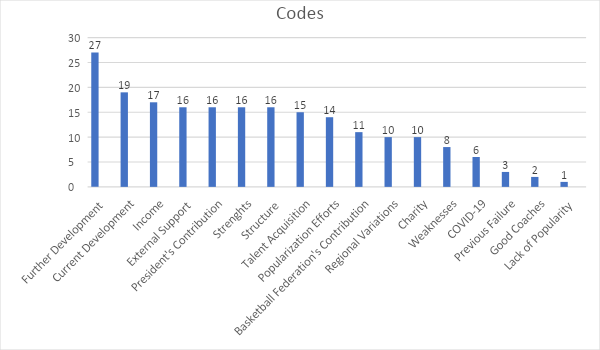
The third stage, the theme development, followed the same approach and logic as those for the Spanish dataset, and three general topics were found. Firstly, the positive aspects of basketball development in the country could be seen through such codes as Income, External Support, Strengths, Structure, Charity, and Good Coaches. Secondly, the negative characteristic features were detected when looking at Regional Variation, Weaknesses, COVID-19, Previous Failure, and Lack of Popularity. Thirdly, all the other codes depicted the explanations and descriptions of how the basketball system was operated in China. The focus was placed on numerous codes, including Further Development, Current Development, President’s Contribution, Talent Acquisition, Popularization Efforts, and Basketball Federation’s Contribution.
During the revision, the fourth stage, the ten interview transcripts were read over again to determine whether the content was aligned with the identified themes. The process was straightforward, and it did not reveal any missing or irrelevant issues in the dataset. That is why it was possible to mention that the three created themes were adequate for the collected data and ultimately reflect the topics covered in the interviews.
Naming was the fifth stage, and it did not imply many differences when compared to the same step for the interviewees from Spain. In particular, the first theme refers to the Advantages that were uncovered during the interviews. These positive aspects focused on versatile income sources, explicit discussions of strengths, productive impact of league structure, charity activities, and coaches’ performance. In addition to that, more representatives of Chinese basketball highlighted the outside support that the country receives from international organizations. The second theme was called the Disadvantages, and it represented all the adverse aspects.
In particular, the term related to unbalanced regional development of basketball in China, many evident weaknesses, COVID-19 consequences, sports failures, and insufficient popularity of basketball in the country. Finally, the Development Processes were the third theme that considered many aspects. For example, the given topic dealt with the current and further development directions, President’s and Federation’s contributions, talent acquisition strategies, and efforts to make basketball popular among the population.
Writing the report was the sixth stage of thematic analysis, and a superficial investigation of the dataset was produced. It is possible to admit that the data spread was similar to the one found for the Spanish respondents. In particular, the Development Processes topic was the most frequently represented because 102 quotations were included. Simultaneously, 77 excerpts made the Advantages theme, while the Disadvantages topic consists of 28 extracts. Even though individual codes were differently represented when the Chinese and Spanish interviews were compared, these discrepancies did not affect the bigger picture. The allocation of themes was similar, and it was reasonable to undertake the analysis of individual answers to uncover the interviewees’ meanings.
The interviewees of the Chinese Basketball Association stated that basketball is very well-developed in China. In particular, the interviewee #11 stated that currently basketball is the second most popular sport in China and its popularity is constantly growing. Statistics show that there are almost 300 million people who like basketball within the country. In this context, the interviewee#20 stated that development is best visible through progress: “Twenty years ago people did not really care about basketball and the level of performance of our clubs was low. Today, we see totally different picture. We have hundreds of millions basketball fans all across the country, our basketball players are among the strongest in the region, while people all across the state absolutely adore watching our national basketball games as well as the games of NBA”. At the same time, the interviewee #15 stated that Chinese national team is the strongest in Asia and the results of basketball clubs on both national and international levels are very good. Still, the respondents acknowledged that the Federation has a lot of directions for improvement and that they are currently in the middle of the reforms.
The question concerning the challenges of the Chinese basketball provoked different answers. The respondent #17 stated that similarly, to all Chinese sports organization, they have some administrative and structural problems, like lack of experience, bureaucracy, lack of financing, etc. At the same time, interviewee #11 stated that currently the largest challenge for the Chinese Basketball Association is Covid-19, as it stopped the economic, social, and sports activities all over the country. Therefore, the Association was forced to suspend all the games for several months. However, thanks to the effective and on-time measures conducted by the Chinese government, China successfully coped with the pandemic and it is expected that they would resume the games in the nearest time. In particular, the association managed to raise more than 3 million yuan inside the league to buy necessary medical and protective supplies to help hospitals in China. At the same time, the interviewee #12 stated that the main challenge for the Association is to compete with the NBA for the audience’s attention.
He also added that they devoted a lot of efforts to increase the interest to professional basketball in China. The interviewee #13 also mentioned that it is difficult to combine the professional basketball and education in China, and therefore many young players have no guarantees in this system. There are not many options for going to college after leaving the professional team. Finally, the interviewee #20 stated that they want fast and big results, while considerable transformation requires a lot of time. Also, there are many factors that are beyond Association’s control and their jurisdiction. However, they are focused not on the problems and pessimism, but on the opportunities and optimism.
While answering the question concerning the main strengths of the country’s Basketball Association, the respondents had quite different opinions. For instance, interviewee #20 stated that the main strength of the Association is the ability to strategically plan for the future and to follow that plan. He also mentioned that they never make empty promises and are always trying to support the words with the real actions. Such strategy is already showing very positive dynamic and they hope that they will manage to maintain it. At the same time, the interviewee #18 stated that the main strength is the people.
In this context, the interviewee #15 mentioned that the Chinese Basketball Association has a strong President, who created a strong team of professionals and all of them are ready to finish Yao’s basketball reformation to increase the interest to Chinese basketball not only in China but on the international level. In addition, many interviewees stated that the Chinese Basketball Federation is actively supported by the government, as they clearly understand the importance of basketball development in the country. Finally, the interviewee #14 stated that the Association actively works with the international, national, and local organizations to organize, promote, manage, develop and support social, educational, cultural, and sporting activities in China.
The answers of the interviewed people concerning the organization, promotion, management, development and support of the different social, educational, cultural and sporting activities for the benefit of basketball (alone or in cooperation with FIBA) were rather similar. For instance, interviewee #11 stated that they organized numerous sports activities in close cooperation with FIBA. At the same time, the respondent #12 stated that they actively cooperate with local, national, and foreign authorities for the organization of different events across the country. For instance, they are very proud for the FIBA Basketball World Cup and FIBA Asia Championship. Such large events are a huge responsibility but they have positive outcomes not only to the popularization of basketball in China but to the development of economic, social, cultural, infrastructural spheres. At the same time, interviewee #19 stated that the Association has organized plenty of educational sporting activities. They try to educate youth concerning the benefits of doing sports, of playing basketball and of leading the healthy way of life.
All the interviewees stated that the Chinese Basketball Association managed to secure the stability of the main resources through different tools. The respondent #20 stated that in the past Chinese Basketball Association was very dependent financially on the state funding. Their basketball was not very commercial. Having limited resources, it was difficult to develop and to stay competitive internationally. However, they changed the financial approach successfully and today they use the sponsorship, fundraising, broadcasting rights, as well as many other tools to stay afloat. The respondent #3 stated that the Association is constantly working with businesses to get additional financing to basketball development and promotion. For example, they actively used corporate naming sponsorship. As an example, he states that “CBA was known as the Hilton League (1999–2001), Motorola League (2001–2003), and China Unicom League (2003-2004).
Nowadays, they decided not to change the name of CBA league every season, however, they signed several profitable sponsorships contracts with China Life Insurance Group, Tissot, Yili Group, Panpan Foods, McDonalds, Li Ning, Anjuke, ChimeLong, China Mobile, Stanley Black & Decker, and many others. Also, in January they signed a sponsorship contract with Pisen Electronics and it became an official sponsor of the CBA League. Also, we have a lot of sponsorship agreements with well-known Chinese and international companies. The interviewee # 8 also mentioned the Chinese government as a source of financing. Still, the respondent #11 stated that the financial stability of the Chinese Basketball Association is a very complicated question, since it depends on numerous factors.
The interviewees of the Basketball Association stated that they support charity and social and humanitarian development programs through basketball in many different ways. In particular, they organize and manage different events for youth to encourage them to participate in different sporting activities and to lead the healthy way of life. Similarly, with other social events they are always ready to provide the infrastructure and staff to help in the organization of support charity and social programs. Also, they cooperate with the clubs to involve them to participate in charity events. During the year they provide the assistance and participate in hundreds (both small and large) events in different parts of China. The Basketball Association clearly realizes that basketball is not only a popular sport but an effective way to improve social situation in the country.
In particular, recently, they participated in charity events to support Chinese hospitals and people to support them during COVID-19 pandemic. Also, CBA members donated blood in special blood donor centers. Finally, the interviewee #10 stated that the president of the Basketball Federation Yao Ming has own charitable organization called Yao Foundation, which seeks to motivate teenagers to play basketball and to make them enjoy this game. It raises the financial resources through the special charity tour. Then, these funds are further used for the promotion of sport education in the rural regions. The foundation also makes donations of the sporting equipment to schools, depending on their needs.
When answering the question concerning the transformation or change that is very important for the country’s Basketball Federation, the respondents presented different answers. For instance, the interviewee #13 stated that some of the basketball educational methodologies that China is using are becoming outdated, therefore it is necessary to develop more progressive approach and this is what Yao Ming is currently doing. At the same time, the respondent # 14 stated that it is necessary to improve the quality of basketball coaches in China, to make them more professional. The interviewee #16 supported that opinion stating that they wish to change youth training approaches and to implement modern youth training standards that will help to provide more effective players development.
In this context, the interviewee #17 stated that it is necessary to develop digital marketing: “The digital world and social media are very significant for Chinese society. We have more than 800 million daily Internet users that turn digital marketing in one of the key tools to promote basketball. Thus, while the capacity of our basketball arenas is limited not everybody can visit the basketball game when he/she wants. Thus, it is important that all Chinese people have easy access to watch basketball games on their phones, tablets, and PC online”. Finally, the interviewee #20 stated that the long term goal of the Association is to find or develop as much “Yao Mings” as possible, as it would impact considerably the overall quality of the game. In other words, he believes that the main transformation should relate to the process of talent acquisition and talent development.
When answering the question on the impact of the President of the Basketball Federation on the development of this sport, all the respondents were highly satisfied with Yao Ming. In particular, interviewee #11 stated that “Yao Ming is a great President and we are proud to work with him. He is not only an amazing player, but an outstanding leader and manager. His impact is very significant, as he actively uses all his experience, skills, and knowledge to transform CBA and to develop a complete commercial ecosystem that will help to make the clubs more profitable”. At the same time, many respondents also mentioned that Ming’s transformations are important, since he played in NBA and can adapt the experience of it in China, making basketball in this country more progressive and advanced.
The answers of the respondents showed that the Basketball Federation contributes to the development of the national basketball team in many different ways. For instance, the interviewee # 12 stated “We are responsible for the development of basketball in China and the excellent performance of the national team is our priority. Thus, we closely and actively cooperate with clubs, players, and their agents to improve our cooperation and to find necessary solutions to the current problems”. Overall, the success of the national team is one of the main targets for them. Chinese Basketball Association actively works with clubs both in China and in other countries to monitor the progress of the players. At the same time, the respondent #12 stated that for them it is very sad that the national basketball team did not manage to qualify for the Tokyo Olympic Games.
Having qualified for all Olympics Games since 1984, this negative result shocked all the country and Basketball Association, in particular. He added that they are discouraged with the results of the national team and have already launched a wide set of reforms). In this context, the interview #16 stated that the President Yao Ming used his connections in the NBA and organized a set of friendly games between players of the Chinese national team and NBA teams (Miami, Charlotte Hornets, and Sacramento) at NBA Summer Games. Thanks to this Chinese players received an outstanding experience from those games and made necessary lessons from the mistakes. It is interesting to mention the other transformation described by the respondent #17. He stated that in the past the members of the Chinese Basketball Association were afraid to send the best Chinese players abroad, as they thought they will never return to China. However, nowadays the Association significantly encourages Chinese players to get overseas experience, as it helps to increase the level of international competitiveness of the Chinese national team.
There were many different answers in relation to the promotion of basketball development within the country. In particular, the respondent #12 stated that “We have already developed a market strategy that covers relationships with sponsors, media sales, brand promotion, commodity authorization, theme retail, youth basketball development, and many other approaches to promote basketball”. The Chinese Basketball Association works actively with the clubs to improve their marketing approaches. They work closely with the clubs and the government to increase the interest to basketball in all the aspects, from game performance to marketing campaigns across the country. For instance, after the careful and in-detail consultations and cooperation with marketing specialists, some clubs changed their names and logos to improve their promotional features.
Also, they are very active in social media and have hundreds of thousands of followers there). In this context, the interviewee #16 stated that the Association contributes to attracting more visitors to the games through improvement of the marketing approaches, as well as the relationship with fans. In addition, the Association organizes special courses for the management of Chinese professional clubs to share the latest trends in the basketball promotion. Also, the organization actively works with Chinese people to invite them to the stadiums and to provide them more information about Chinese basketball. In his turn, the interviewee #18 mentioned that Chinese people do not have access to the popular Western social networks like Facebook, Instagram, YouTube, and other similar web-sites, thus they use only Chinese social networks to promote basketball. Finally, respondent #19 stated that the Association has a long-term strategy of basketball promotion, which is focused on digital marketing, PR, communication, and others.
While answering the question on the differences in the regional development of basketball in China, the respondents had different answers. For instance, the respondent #20 stated that China has big country and big population, therefore it is difficult to reach the full regional equality. The Association does not try to discriminate anyone, but still they try to provide everyone equal opportunities not only to basketball, but to sport in general. In addition, the respondent #12 stated that currently, the Western and Central parts of China have poorly developed basketball. Thus, there are only two professional clubs that currently represent CBA from these regions: Xinjiang Flying Tigers that is based in Ürümqi, Xinjiang and Sichuan Blue Whales that is based in Wenjiang District, Chengdu, Sichuan. The interviewee 17 supported this opinion, stating that “There are twenty-three provinces in China. However, almost 60% of all domestic basketball players came from only six Chinese provinces: Heilongjiang, Hebei, Jiangsu, Jilin, Liaoning, and Shandong. Similarly, top basketball clubs represent these provinces”. However, the Chinese Association actively works to improve the regional development of basketball within the country in the short-term and in the long-term run.
The question concerning the increase of the interest of the audience (spectators) to basketball China got mixed replies. For instance, the interviewee #16 stated that the Chinese basketball association invests a lot in the development of infrastructure, marketing, brand recognition to make the country’s basketball more recognizable and popular on both national and foreign markets. At the same time, the interviewee #13 stated that they think that popularization through the social media as very important. In particular, he stated: “We launched two official accounts of CBA league in the most popular Chinese social media platforms Weibo and WeChat.
There we release the latest news, results, official clubs updates, and many other useful information. Also, you can visit our official website to read more about the current reforms in Chinese basketball”. In this context, the interviewee #15 stated that Chinese Basketball Association plans to invest a lot in marketing of the basketball clubs (changing the names of the teams and logos, developing the custom made trophies for the winners, making the merch more modern). Finally, the interviewee # 20 stated that they plan to organize basketball festivals and basketball events of different scale. They help to attract attention and to keep interested the fans. They also plan to have many popularization events with NBA, as they are real professionals about advertising and marketing of basketball.
The answers to the question concerning the main sources of income for the basketball clubs in the country were more or less the same. For instance, the interviewee #12 stated that Basketball clubs in China are coordinated and supported by local sports committees and businesses. They have a great opportunity to sign very profitable marketing contracts. Also, they actively work with both national and foreign investors to secure their financial security, to invest in the development of infrastructure and to buy best foreign players. For example, Beijing Ducks signed a long-term contract with Shougang Steel, Shandong Heroes signed a large corporate sponsorship contact with Shandong Hi-Speed Group. Thus, over the last decade, more than 200 foreign players (from the U.S., Europe, Turkey, Israel, and other countries) played in the CBA. At the same time, the revenues of the top basketball clubs are significantly lower than their spending.
The question concerning the structure of the first-tier professional men’s basketball league and its performance got similar answers among the respondents. In particular, the respondent #16 stated that there are two divisions with 10 clubs in each. The Northern division is represented by the following clubs: Beijing Ducks, Beijing Royal Fighters, Jilin Northeast Tigers, Liaoning Flying Leopards, Qingdao Eagles, Shandong Heroes, Shanxi Loongs, Sichuan Blue Whales, Tianjin Pioneers, and Xinjiang Flying Tigers. At the same time, the Southern Division is represented by the following clubs: Bayi Rockets, Fujian Sturgeons, Guangdong Southern Tigers, Guangzhou Loong Lions, Jiangsu Dragons, Nanjing Monkey Kings, Shanghai Sharks, Shenzhen Aviators, Zhejiang Golden Bulls, and Zhejiang Guangsha Lions. This structure helps to increase the interest to the CBA league. At the same time, the respondent #17 stated that “We successfully applied NBA’s structure of the first-tier professional men’s basketball in China. I think, it is the most appropriate variant for China too”. Many other interviewees supported this opinion.
The question concerning the specific talent acquisition approach was answered with a lot of details by the respondents. For instance, the interviewee #20 stated that in the past their approach in terms of talent acquisition was based on the Chinese sport traditions, however now they have started to use more the international experience. He considers such synergy between the new and the old as very important. The Chinese Association pays significant attention to youth development. The country has a large potential as millions of Chinese children and adolescents actively train to become new basketball icons like Yao Ming. China has very-well developed infrastructure for youth training.
Thus, everyone has an opportunity to join the basketball courses and to become a famous basketball icon as Yao Ming. Moreover, Chinese basketball school is the best in Asia and one of the most developed in the world. Thus, they have hundreds of very-talented basketball players in each age group that allows them to participate successfully at all levels. Moreover, to promote basketball, Chinese Basketball Association helps to organize basketball camps and different training opportunities for the Chinese youth. For example, Nike Youth Basketball Camps are very popular in China. They are directed and organized by well-known professionals. For example, one of them was directed by Brendan Winters (Director of PSB Charlotte) and Ross Schraeder, Director of PSB Denver. The Chinese government argues that Chinese kids should participate more in sports and they made large financial investments into the youth basketball field development. All these efforts help to find young talents on time.
Now there are many innovations in the construction of the youth training system of the Chinese Basketball Association, such as the elite program, allowing young players with potential to go abroad for basketball training and cultural education training. Also, the young basketball players can get international scholarships, and therefore to develop own basketball skills and talents. It can considerably help to enhance the overall international competitiveness of Chinese basketball projects. In this context, interviewee #16 stated that Chinese Basketball Association cooperates with several foreign clubs (for example, ALBA Berlin) and brands (for example, Nike) that organize training, camps, and different kinds of competitions for youth. They signed long-term cooperation with ALBA to promote youth exchanges between China and Germany.
Thus, best players have the opportunity to train in different environments under the guidance of best coaches. As well, they have already launched cooperation with Jr. NBA. The Jr. NBA organizes various junior tournaments, in which over four million Chinese students participated. Also, there several NBA Academies and a joint basketball school that significantly contributed to talent acquisition and youth training.
While answering the last question of the interview concerning following the NBA style, the respondents provided the range of interesting answers. For instance, the interviewee #13 stated “Yes, the NBA was a role model for the development of CBA. We actively invited NBA members and representatives of USA Basketball Federation to share experience and to contribute to the development of basketball in both, the U.S. and China. At the same time, nowadays, we try to develop our own identity in CBA, as it is very important for further promotion of basketball in China”. Still, NBA has taught China a lot, but they do not want to have the same system, because NBA is too capitalistic and commercialized and China does not really share these values. At the same time, the respondent 17 stated that they actively cooperate with the colleagues from the Basketball Associations from all over the world, not only with NBA.
Presentation of the Results of the Questionnaire
Questionnaire in Spain
As it is visible from Chart 1, the survey participants represent almost equally all age groups (U-12, U-14, and U-17) that were selected for a current study. It allows to receive reliable data from the young Spanish basketball players of different age. 80% of the respondents professionally play basketball for at least 1 year, while 40% of them play basketball for more than 2 years. Thus, it is possible to underline that respondent knows the inner situation and their answers can represent clearly the situation in Spanish youth basketball. Chart 3 shows that most of the respondents are satisfied with the professional of their coaches in terms of the training process (60%), communication with players (61%), positive feedback (51%), social and psychological support (45%), and professional development (80%). Similarly, most of the respondents are satisfied with the professional level of their teammates.
In particular, the highest marks were received for communication with teammates, team atmosphere, and the training process. Also, 92% of the respondents (53% of them strongly agree) agree that individual player development (dribbling, passing, shooting, etc.) is evident over the course of the training (see Chart 5). Moreover, the statement that team play development is evident over the course of the training (using teammates, team coordination, supporting one another) was supported by 87% of the respondents (49% of them strongly agree) (see Chart 6). Overall, 99% of the respondents feel that they improved themselves as basketball players and got a better understanding of basketball over the course of the training (see Chart 7).
Talking about self-practice and additional training, 19% of survey participants mentioned that they perform additional training on a daily basis, while 49% of the respondents state that they make additional training a few times per week (see Chart 8). Moreover, 68% of the young Spanish players at least one time participated in summer basketball camps, while 27% of them participate in professional summer basketball camps every year (see Chart 9).
Talking about the level of basketball development in Spain, most of the respondents are satisfied with it (infrastructure (60% both satisfied and highly satisfied), financing (22%), professional level of coaches (76%), support from the government (41%), and strength of the championship (55%)) (see Chart 10). At the same time, a large part of the respondents is unsatisfied with the basketball financing and governmental support of basketball in Spain. Chart 11 illustrates that 55% of the questionnaire respondents underlined that the competition between the teams in the Spanish basketball league where they currently play is tough or very tough (35% and 20%, respectively).
Finally, when the respondents were asked to rate their level of physical capabilities, in terms of agility, coordination, reaction, speed, and strength the following results were received. Agility, coordination, reaction, and speed was marked as excellent by 40%, 40%, 35%, and 37% respondents, respectively), while 50%, 45%, 54%, and 44% respondents, respectively underlined that these physical capabilities as good (see Chart 12). At the same time, strength was rated as average by 55% and as good by 45% of the respondents.
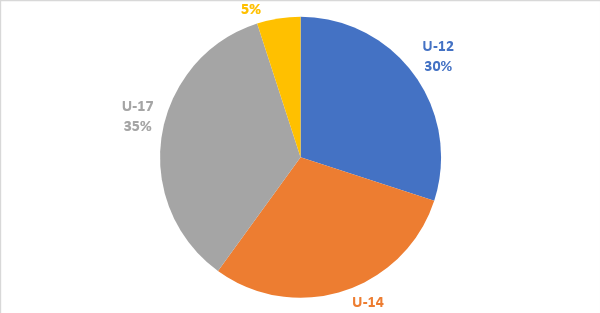
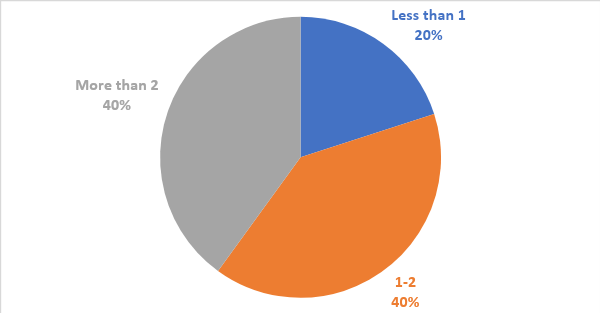
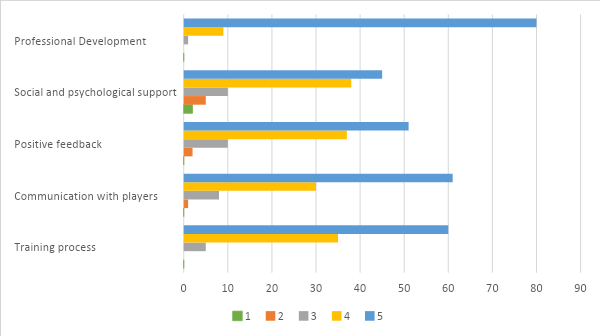
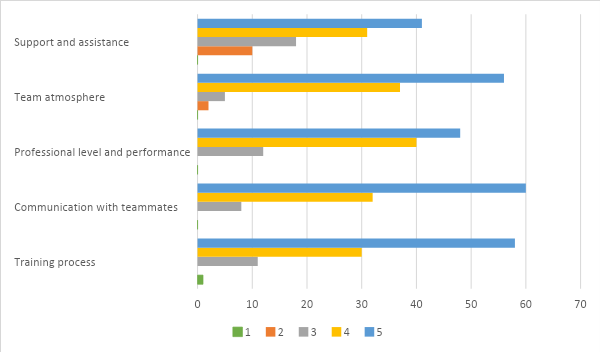
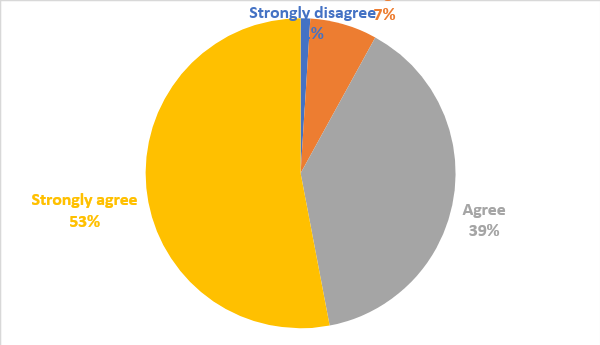
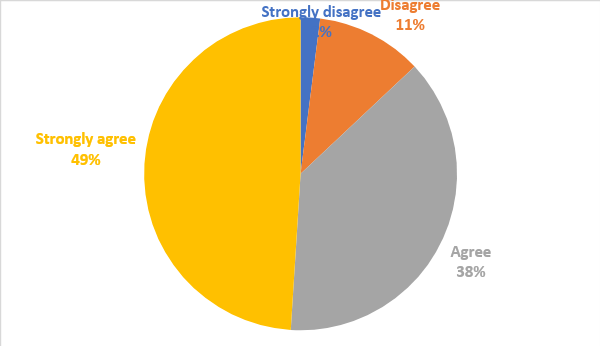

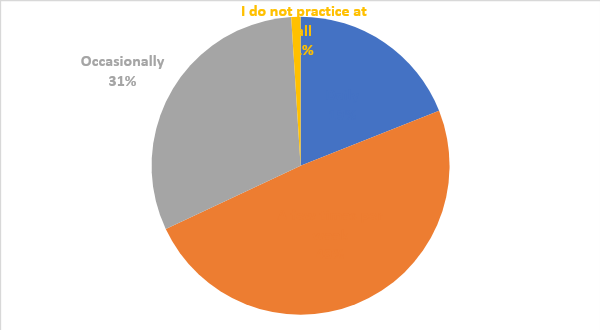
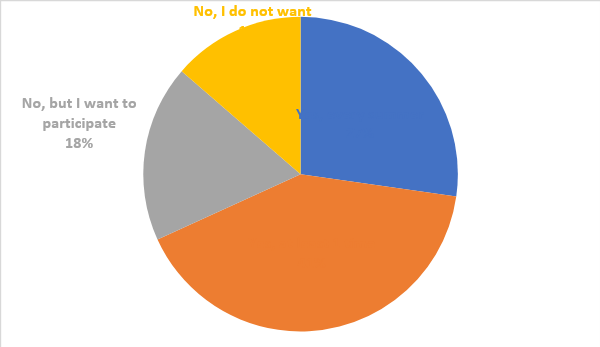
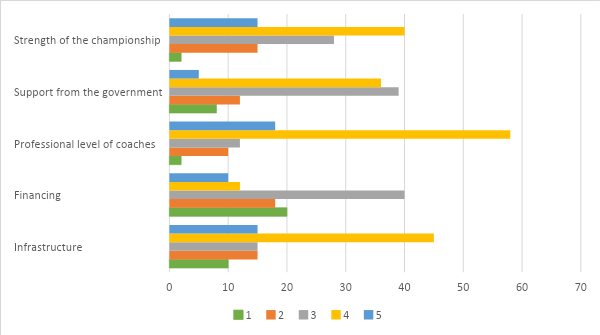
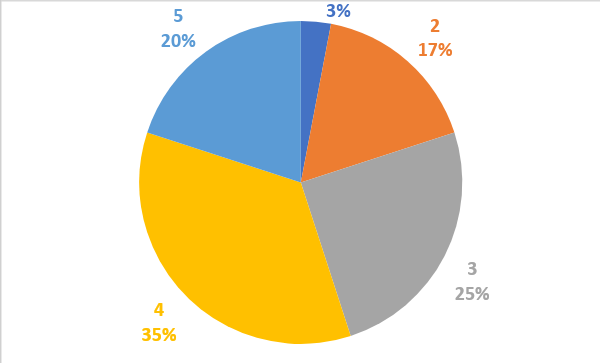
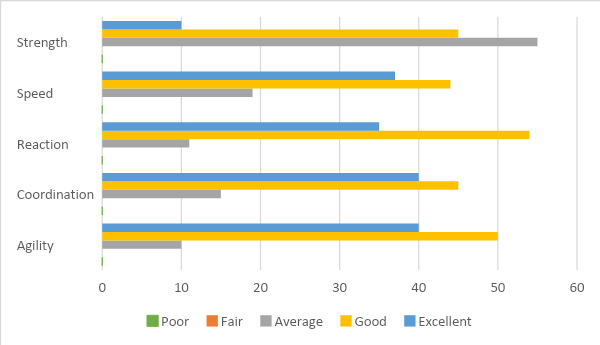
Questionnaire in China
The questionnaire participants represent all age groups (U-12, U-14, and U-17) almost equally that makes the current survey representative and statically valid. Moreover, 97% of the respondents play basketball for at least one year, while 75% of them play basketball for more than 2 years (see Chart 14). Most of the Chinese respondents are not satisfied with the professional level of their coaches. In particular, Chinese respondents mentioned low satisfaction with training process (56% (both 2 and 3 marks)), communication with players (54%), positive feedback (58%), social and psychological support (61%), and professional development (55%) (see Chart 15).
Moreover, professional development and social and psychological support received from some respondents the lowest mark 1 (see Chart 15). Similarly, Chinese young basketball players underlined satisfaction with their teammates in terms of training process, communication with teammates, team atmosphere, and support and assistance (79%, 94%, 67%, and 66%, respectively (marks both 4 and 5)) (see Chart 16). At the same time, some respondents were unsatisfied (mark 2) with their teammates in terms of the professional level and performance (26%), team atmosphere (16%), and support and assistance (21%) (see Chart 16).
In terms of individual player development over the course of the training (dribbling, passing, shooting, and others), 93% of the respondents agree or strongly agree with this statement (see Chart 17). Similarly, 79% of the respondents agree or strongly agree that team play development is evident over the course of the training (see Chart 18). Also, as it is visible from Chart 19, 98% of the respondents feel that they are improved as players and got a better understanding of basketball over the course of the training). Moreover, 54% of the respondents practice on their own a few times per week (39%) or on a daily basis (15%) (see Chart 20). Furthermore, 64% of the Chinese respondents never participated in basketball summer camps, while 59% of them have a desire to participate (see Chart 21).
Most of the respondents underlined that they are satisfied with financing and support from the government (see Chart 22). However, three positions, professional level of coaches, development of the infrastructure, and the strength of the championship received high percentages of low satisfaction, 40%, 35%, and 53%, respectively (marks 1 and 2) (see Chart 22). Moreover, according to Chart 23, 65% of the respondents (marks 2 and 3) evaluated the competition between the teams in the basketball league where they are currently playing as not tough.
Finally, Chart 23 shows a level of satisfaction with the respondents’ physical capabilities (agility, coordination, reaction, speed, and strength). It is visible that most of the respondents 41%, 35%, 32%, 39%, and 40%, respectively stated that their physical capabilities are good, while 52%, 46%, 44%, 37%, and 35%, respectively underlined that their physical capabilities are average (see Chart 24). At the same time, 7%, 19%, 24%, 24%, and 25%, respectively of the survey participants stressed that their physical capabilities are excellent (see Chart 24).
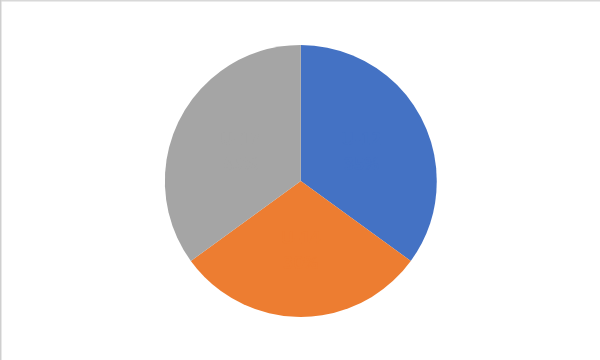
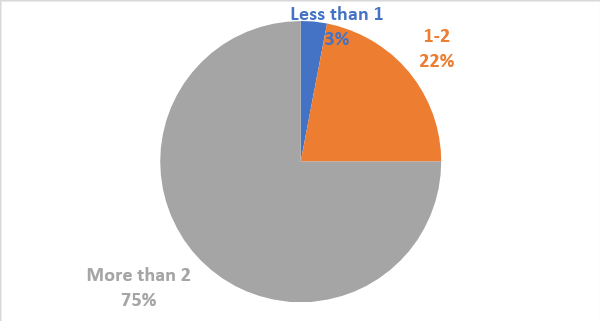

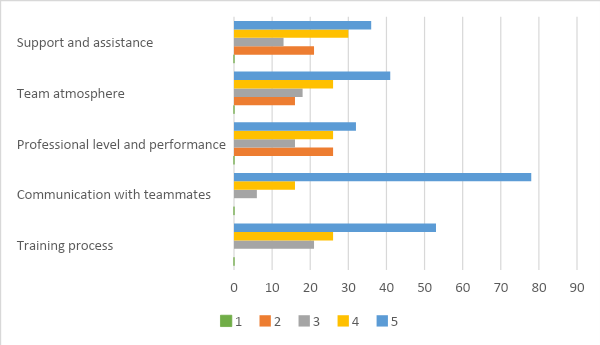
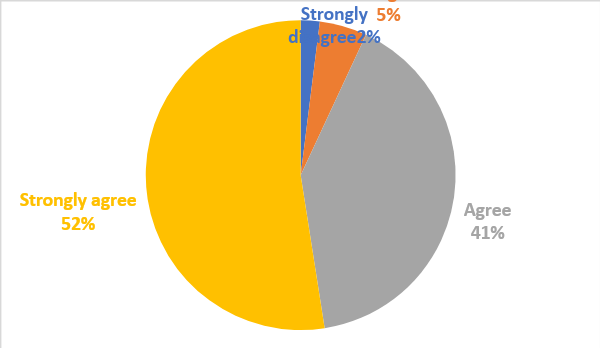
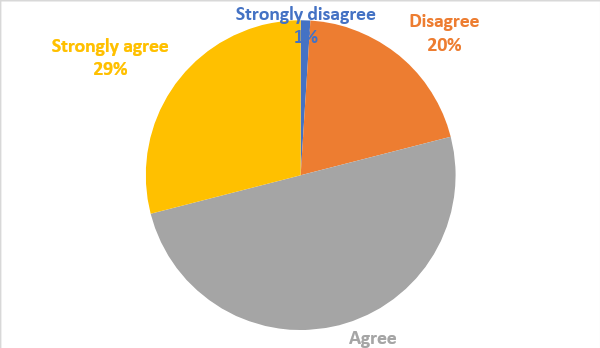
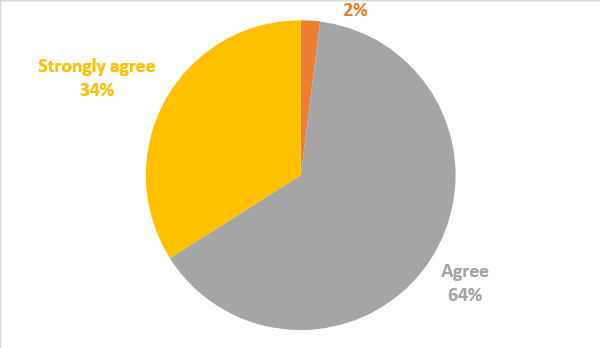
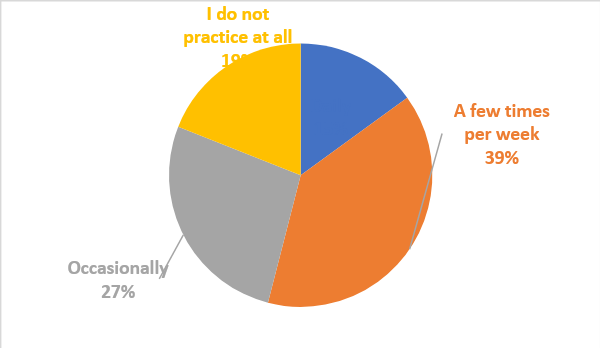
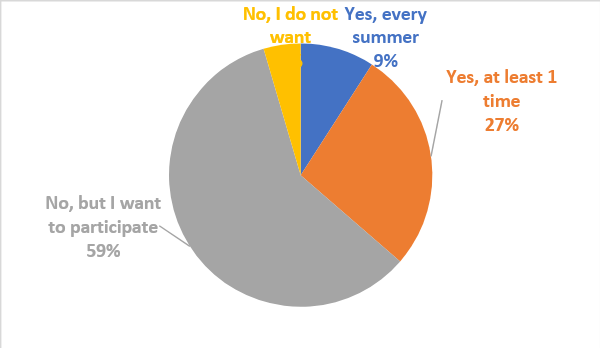
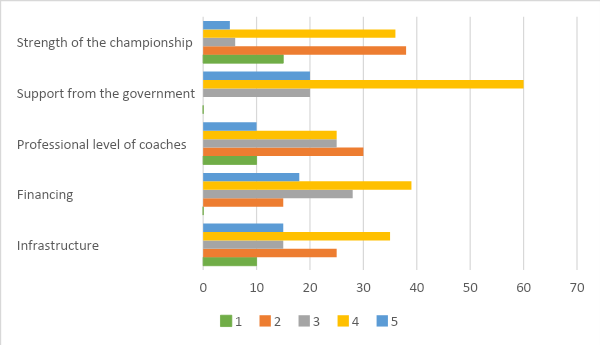
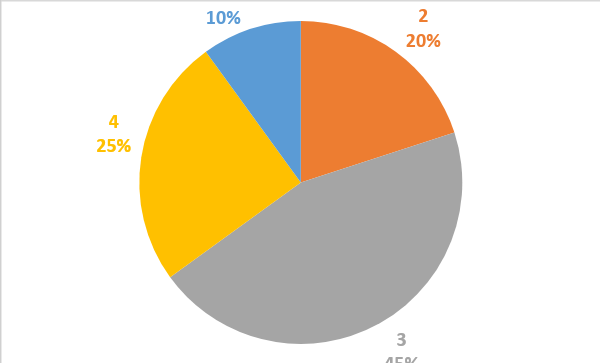
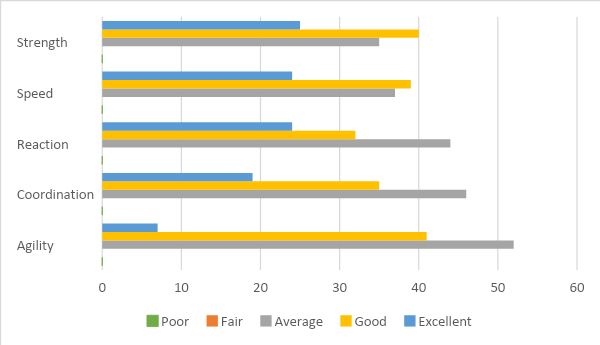
Discussion of the Results
Discussion of the Results of the Interviews, Questionnaire and Secondary Data Analysis
After the careful analysis of the interviews, the questionnaire and literature review, it is possible to state that there are many similar and distinct features between basketball organizational systems in China and in Spain. They are all described in detail in the following table.
Table 7. Similarities and Differences between Basketball Organizational Systems in China and in Spain.
The analysis of the primary and the secondary sources gave the possibility to find both weak and strong sides of each country in the development and advancement of basketball. The research has also found out that with the flow of time (from U12 to U21) the performance of the players (in terms of strength, speed, coordination, reaction and agility) in China and in Spain start to differ, which can be explained by the different talent acquisition, training approach, coaching, motivation, level of competition, and economic potential of the profession.
The received data illustrated that it is important for Chinese basketball to stay more open towards the implementation and adaptation of the NBA model to the Chinese experience. Nowadays, the NBA is the most prominent and successful basketball league in the world. Thus, Yao Ming’s reforms should be successfully implemented in the nearest future. In-detail evaluation of literature review and interviews with Chinese basketball association authorities illustrated that Ming has already changed the strategy of Chinese basketball development and he provided a new positive view on the basketball evolution in China.
However, currently, Ming has limited power, due to the high level of bureaucracy in Chinese basketball. High-level of bureaucracy and dependence on the political will, significantly lowered Ming’s potential and slowed the entire development of basketball in China. Moreover, the analyzed data demonstrated that there is a significant problem of education in China among Chinese basketball players. Most of the players join special sports schools, where the physical performance development significantly harms the intellectual development of the player and therefore prevents the players from reaching their full potential on the field. Education is an essential part of the training process and it is important not to limit access to it.
Moreover, the analysis of interviews showed that there is a significant problem with the new basketball talents development in China. China needs new ‘Yao Mings’ at both national and top foreign leagues to promote basketball on local and international levels. The data showed that something is wrong about finding the talents and about developing them into the top-level basketball players. Furthermore, secondary data analysis, evaluation of interviews and questionnaires showed that the professional level of Chinese coaches is still very low. Therefore, it is crucial to pay attention to this issue and to organize more training and preparation courses for the coaches to improve their professionalism, their coaching skills, their communication with the basketball players, etc. Thus, this point can be and should be improved, as it is directly connected with the performance of the basketball players.
Moreover, data showed that there is a sufficient problem in access to the basketball infrastructure and basketball camps in China. The basketball camps allow them to better find and develop talents, and to promote their performance, giving the possibility to focus on the improvement of own skills, communication with the other basketball players and coaches. Finally, one of the largest problems is unequal development of basketball across different parts of China. Currently, the gap in regional development is quite big and should be reduced to balance the situation within the country.
Talking about Spanish basketball, data analysis showed that football remains significantly more popular than basketball in Spain. Thus, basketball has lower financing, smaller number of large sponsorship contracts, and poorer attendance of basketball games compared to football. Also, there are a lot of foreign players at clubs at all levels. Thus, very often Spanish players have a smaller percentage of play time and they are forced to join foreign basketball clubs. Also, data evaluation showed that there is poor level of basketball support by the government that negatively affect basketball development and promotion across the country. Data gathered both in interviews and questionnaires demonstrated that Spanish basketball is well-developed at all levels. Basketball infrastructure is accessible to the players of all ages and both coaches and players have good opportunities to train even in small towns. Thus, Spain’s basketball system regularly develops new basketball talents that play both in Spain and in top leagues across the world.
From the first sight, the analysis of the physical tests of basketball players of different ages could be more representative to understand the differences between countries, however it has been decided that it is more logical and efficient to compare the opinion and experience of the basketball players and the representatives of the Basketball Federation of two countries. Their answers showed that Chinese and Spanish respondents have different progress and different answers on the questions about the training process, satisfaction with coaches and teammates. Also, both Federations cannot directly impact the athlete’s performance.
However, they are responsible for the development and promotion of youth basketball in the country. From the one side, the Chinese Basketball Association paid significant attention to the improvement of coaches’ professional level and the development of basketball infrastructure. Similarly, from the other side, the Spanish Federation promoted youth basketball in the country and actively worked with youth and professional clubs to develop a strong foundation for the development of Spanish basketball at all levels. All this impacted the performance indicators of the basketball players in the short-term and in the long-term run.
Recommendations
Recommendations for Chinese Basketball Federation
The following recommendations were developed as a result of profound research (primary and secondary data analysis) for the representatives Chinese Basketball Association:
- To be more open towards the implementation and adaptation of the NBA model to the Chinese experience and context. NBA methods, tools and approaches have proved their profitability, efficiency and productivity on the global scale. In addition, NBA is a global symbol of success in basketball, while NBA players are the sport role models for people all over the world. Thus, borrowing their experience might be useful and relevant for China, especially taking into account the existing long lasting cooperation between the countries in the domain of basketball. The reformation of the basketball system in China according to NBA’s principles would make it more independent, more profitable and more interesting for fans.
- To provide the President of the Basketball Association more power, as currently the unnecessary bureaucracy does not allow Yao Ming to make the necessary reforms and transformations to improve the basketball development within the country.
- To give opportunity to children and teenagers to obtain the normal general school education in addition to sport training. It would help to increase the intellectual level of the basketball players and thus to improve their performance on personal and on team level. Currently, the increased focus on physical performance hinders intellectual development and therefore prevents the players from reaching their full potential (which is only possible with the balanced combination between physical and intellectual development).
- To change the approach to the talent acquisition of the youth and to transform the talent management system. The country does not “produce” the superstar players like Yao Ming in his time any more. It means that something is wrong about finding the talents and about developing them. At the same time, NBA and the range of European countries are much more successful in this domain. Thus, borrowing their experience in terms of talent acquisition and development might be useful.
- To organize more training and preparation courses for the coaches to improve their professionalism, their coaching skills, their communication with the basketball players, etc. The questionnaire showed that currently the Chinese basketball players are not very satisfied with the work of the coaches. Thus, this point can be and should be improved, as it is directly connected with the performance of the basketball players.
- To develop and promote the culture of basketball camps in the Chinese sport culture among the youth. The basketball camps allow to better find and develop talents, and to promote their performance, giving the possibility to focus on the improvement of own skills, communication with the other basketball players and coaches.
- To invest more financial resources in the regional development of basketball in China. Currently, the gap in the regional development is quite big and should be reduced to balance the situation within the country.
Following the above-mentioned set of the recommendations can help to improve the Chinese basketball and to make it more profitable, and efficient in the short-term and in the long-term perspectives.
Recommendations for Spanish Basketball Federation
The following recommendations were developed as a result of profound research (primary and secondary data analysis) for the representatives Spanish Basketball Federation:
- To invest more in the development of youth basketball and popularization of this sport all over the country. Currently, football remains significantly more popular than basketball in Spain. Thus, it is necessary to find the wide range of tools to attract youth to this sport.
- To develop the infrastructural projects for the promotion of basketball. Currently, the basketball infrastructure in Spain is quite well developed, however the improvement in this domain might advance the popularity of this sport within the country even more. The presence and availability of the quality infrastructure helps to promote sport, providing the potential players the possibility to try the game, to watch it and to become interested in this sport.
- To balance the situation with the international players and to provide the possibility for the Spanish players to play. The timing for the international players should be strictly reevaluated. The native players should be offered the attractive conditions of cooperation. Such approach would help to decrease the amount of people who leave Spain to play for the NBA.
- To develop a strategy to deal with the consequences of Covid-19, because the current salary cuts and lack of financing significantly harm the sport industry. The basketball clubs should search for the new ways to attract the financial resources in the contemporary complex and unstable economic and social situation. Potentially, the government could help the Spanish basketball in these unprecedented and difficult times.
- To invest more in the development of strength, speed, reaction, coordination, and agility. Even though Spain demonstrated quite good results in terms of the above-mentioned physical characteristics, they need to be improved to reach the position of “the best” in the world.
- To invest in the development of the new young stars that could shine in the national team as bright as Pau Gasol, Serge Ibaka, Nicola Mirotic, and Sergio Rodriguez Gomez. Even though there are many talented players in the national team
- To continue adapting NBA experience to the Spanish context and experience, in order to make Spanish basketball more profitable and more interesting for fans. The Spanish basketball stars should become as popular as the NBA stars and it is a hard continuous work related to many aspects.
Following the above-mentioned set of the recommendations can help to improve the Spanish basketball and to make it more profitable, and efficient in the short-term and in the long-term perspectives.
Conclusion
General Conclusions
The main goal of this research was achieved. The comparative analysis of the basketball organization system in China and in Spain was realized. Within this wider goal, the research has reached the following concrete objectives:
- the contemporary basketball systems in China and in Spain are overviewed, presented and compared;
- the strategies of coaching of the Chinese and Spanish basketball teams are examined and compared;
- it was examined how the relations between the basketball players and the coach, and the relations within the team influence the performance of the players and the teams in China and in Spain;
- the difference between the self-development of basketball male players in China and in Spain was determined;
The main research questions of this study were answered. The common features and distinct features between the Spanish and Chinese Basketball Federations were outlined in the form of the table. The difference between the basketball organizational systems in China and in Spain was determined (including the training, self, development, motivation and performance of the basketball players).
The hypothesis was proved. In the U12 which younger age group, young players who have just been exposed to basketball training do not show a large difference in data. As the age increases and the various indicators of training gradually shows out the differences. It happens due to differences in training approach, organizational structure and general Chinese specific approach to basketball.
Limitations of the Study
This comparative analysis of the basketball organization system in China and in Spain has the range of limitations. The first limitation relates to the utilized methodological tools. This study uses three key methods – secondary data analysis, interview and questionnaire. Thus, the results are quite limited with understanding of the situation from only the qualitative methodology perspective. The second limitation also relates to the methodology, since the information that was obtained depended a lot on the chosen sample. Interviewing the other people and making the questionnaire with the other respondents could potentially lead to the slightly different results. Thirdly, the results of the study are limited to the analysis of only the representatives of the Basketball Federations of China and Spain and of the basketball players of these countries respectively, however it does not largely take into account the opinion of the other representatives of the basketball domain. Fourthly, even though the thesis mentions the historical aspect of the basketball organizational system in China and in Spain, it focuses more on the present than on the past. Finally, the paper compares only two countries, China and Spain, and does not take into account the other states. The above-mentioned limitations should not be considered as the disadvantages of the research, but rather they allow achieving the clearer focus to the thesis, preventing the unnecessary distraction to the unnecessary information.
Prospects for the Future Research
In the future, this thesis of the basketball organization system in China and in Spain can be complemented in several ways. First of all, the qualitative methodology of the thesis can be expanded and improved. The other qualitative methods can be used, such as the case study, observation, etc. to complement the interview and questionnaire. In addition, the sample size for the interview and questionnaire can be increased, while the new questions can be added. Secondly, not only qualitative, but also quantitative methodology can be used to evaluate and assess basketball organization system in Spain and China. For instance, the researcher can use wide range of the quantitative methodological tools and computer statistical software to examine better the measurable indicators of the basketball players’ performance.
Potentially, the analysis from the quantitative perspective could provide the new way of understanding the data and to increase the reliability and validity of the research results. Thirdly, in the future the study can analyze not only the representatives of the Basketball Federations and the representatives of the basketball teams of China and Spain, but also some other specialists in the domain of basketball, whose point of view may be important and interesting for the more profound understanding of the theme. Fourthly, the future research may demonstrate how economic, political, social and cultural factors impact and shape the development of basketball in the analyzed countries (China and Spain). Finally, it would be also interesting to analyze and compare the experience of China, Spain and NBA in this context, as currently the latter is the world leader in the field of basketball.
References
Adhabi, E., & Anozie, C. B. (2017). Literature review for the type of interview in qualitative research. International Journal of Education, 9(3), 1-12.
Bonal, J., Lorenzo, A., Jimenez, S. (2019). Key factors on talent development of expertise basketball players in China. Journal of Sport Psychology, 28(1), 9-16. Web.
Braun, V., Clarke, V., & Weate, P. (2017). Using thematic analysis in sport and exercise research. In B. Smith & A. C. Sparkes (Eds.), Routledge handbook of qualitative research in sports and exercise (pp. 191-205). Routledge.
Buñuel, P., Ibáñez, S., Fuentes-Guerra, J, Sierra, A., & Sánchez, M. (2005). Multifactor characteristics in the process of development of the male expert basketball player in Spain. International Journal of Sport Psychology, 36(2), 151-171.
Cañadas, M., Gómez, M.-Á., García-Rubio, J., & Ibáñez, S. J. (2018). Analysis of Training Plans in Basketball: Gender and Formation Stage Differences. Journal of Human Kinetics, 62(1), 123–134.
Chen, X., & Chen, S. (2021). Sports coaching development in China: The system, challenges, and opportunities. Sports Coaching Review, 1-22.
FIBA (2019). Biggest-ever FIBA World Cup reaches record-breaking three billion people. FIBA Basketball. Web.
FIBA Basketball Spain (2020). Federacion Espanola de Baloncesto. FIBA. Web.
FIBA Basketball China (2020). Basketball Association of the People’s Republic of China. FIBA. Web.
Gao, H. (2012). From Mao Zedong to Jeremy Lin: Why Basketball Is China’s Biggest Sport. The Atlantic. Web.
González, J. C., Ayuso, J. M., Lekue, J. A., Leibar, X., Erauzkin, J., Jukic, I., … Terrados, N. (2018). Anthropometry and performance of top youth international male basketball players in Spanish national academy. Nutrición Hospitalaria, 35(6), 1331.
Hancock, B. (2013). Globalization of the NBA. Forbes. Web.
Ibanez, S. J., Saenz-Lopez, P., Feu, S., Gimenez, J., & Garcia, J. (2014). Progression of Spanish National Team Basketball Players by Age and Sex. The Open Sports Sciences Journal, 3(1), 118–128.
Lavrakas, P. (2008). Purposive sampling. Encyclopedia of Survey Research Methods.
Ministerio De Cultura Y Deporte. (2019). Anuario De Estadísticas Deportivas. Report.
Moya, A. (2018). Comprehensive comparison between Spanish and Chinese basketball. Master’s Thesis, Universidad Catolica San Antonio de Murcia.
Nair, P. K. R., & Nair, V. D. (2014). Organization of a Research Paper: The IMRAD Format. Scientific Writing and Communication in Agriculture and Natural Resources, 13–25.
Nowell, L. S., Norris, J. M., White, D. E., & Moules, N. J. (2017). Thematic analysis: Striving to meet the trustworthiness criteria. International Journal of Qualitative Methods, 16(1), 1-13.
Prasad-Nayak, M. and Narayan, K. (2019). Strengths and weaknesses of online surveys. Journal of Humanities and Social Science, 24 (5):31-38.
Questionnaire. (2020). Merriam Webster Dictionary. Web.
Riches, S. (2013). Basketball and Globalization. The New Yorker. Web.
Retro Basketball Highlights (2015). Michael Jordan Swishes Free Throw With Eyes Closed. Retro Basketball Highlights. Web.
Sánchez, M. (2002). El proceso de llegar a ser experto en baloncesto: un enfoque psicosocial. Doctoral Thesis. Universidad de Granada, Granada.
Shorten, A., & Smith, J. (2017). Mixed methods research: expanding the evidence base. Evidence Based Nursing, 20(3), 74–75.
Sincero, S. (2020). Pilot survey. Explorable. Web.
Slusher, A. (2016). An International Crossover: Comparing The Chinese Basketball
Association with The National Basketball Association. The University of Mississippi. Web.
Smith, B., & Sparkes, A. C. (2017). Interviews: Qualitative interviewing in the sport and exercise sciences. In B. Smith & A. C. Sparkes (Eds.), Routledge handbook of qualitative research in sports and exercise (pp. 103-123). Routledge.
Tan, T.-C., & Bairner, A. (2011). Managing Globalization: The Case of Elite Basketball Policy in the People’s Republic of China. Journal of Sport Management, 25(5), 408–422.
Torres-Unda, J., Zarrazquin, I., Gil, J., Ruiz, F., Irazusta, A., Kortajarena, M., … Irazusta, J. (2012). Anthropometric, physiological and maturational characteristics in selected elite and non-elite male adolescent basketball players. Journal of Sports Sciences, 31(2), 196–203.
Vanclay, F., Baines, J. T., & Taylor, C. N. (2013). Principles for ethical research involving humans: ethical professional practice in impact assessment Part I. Impact Assessment and Project Appraisal, 31(4), 243–253.
Vasileiou, K., Barnett, J., Thorpe, S., & Young, T. (2018). Characterising and justifying sample size sufficiency in interview-based studies: systematic analysis of qualitative health research over a 15-year period. BMC Medical Research Methodology, 18(1).
Wallbank, D. and Cang, A. (2019). How a Quickly-Deleted Tweet About China Got Pretty Much Everyone Mad at the NBA. Time. Web.
Zhang, Y. (2016). Management and Regulation of Basketball Training Process. Proceedings of the 2016 4th International Conference on Management, Education, Information and Control (MEICI 2016).